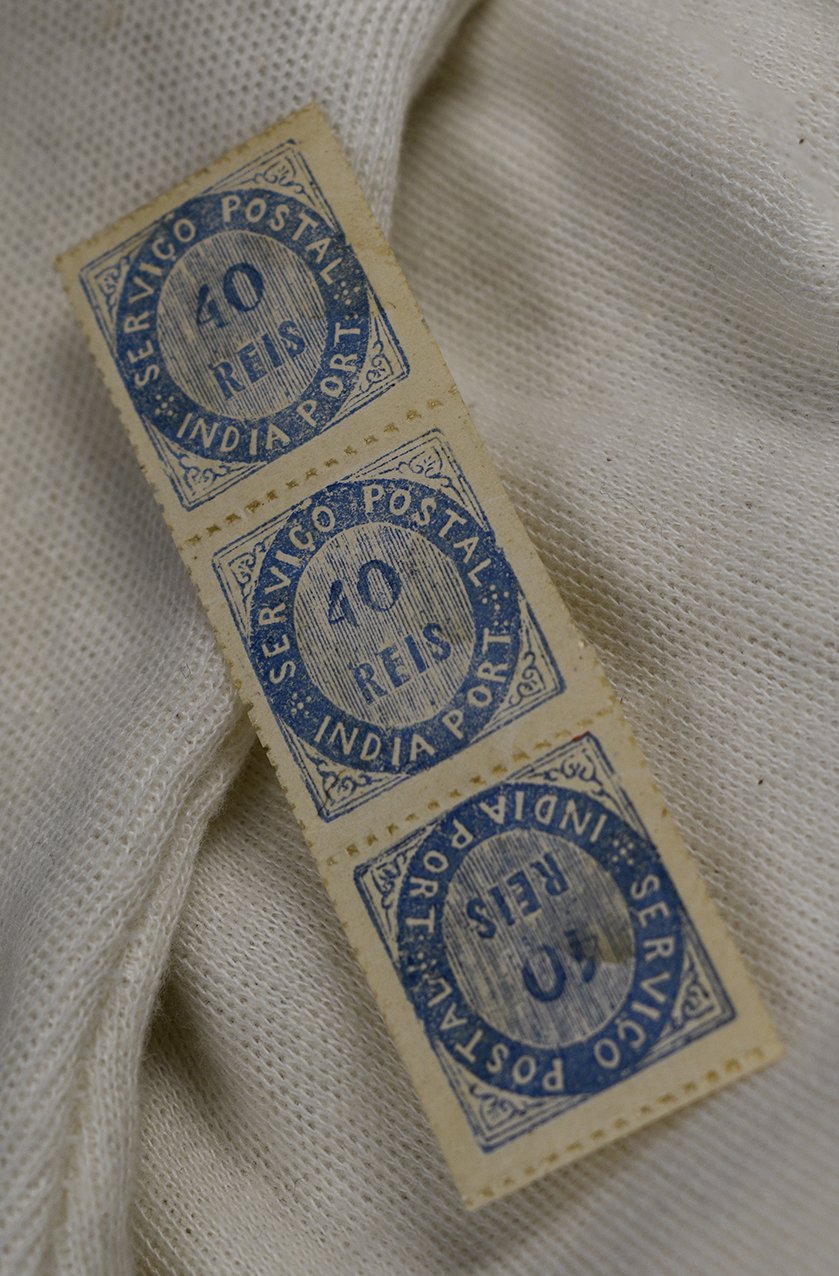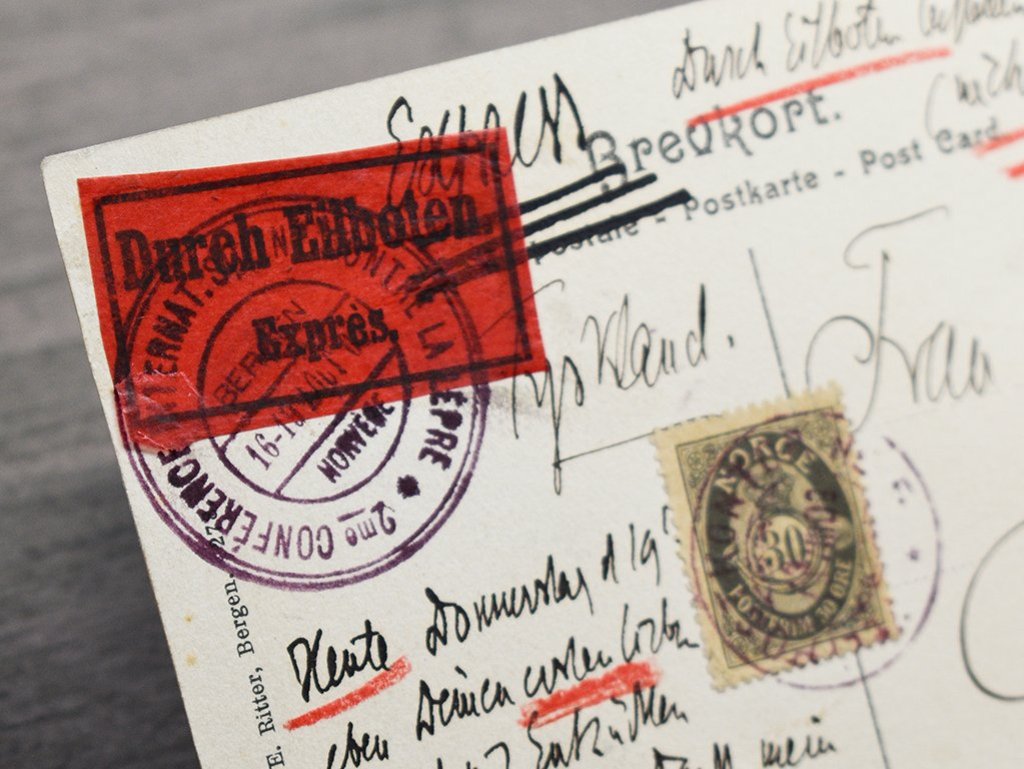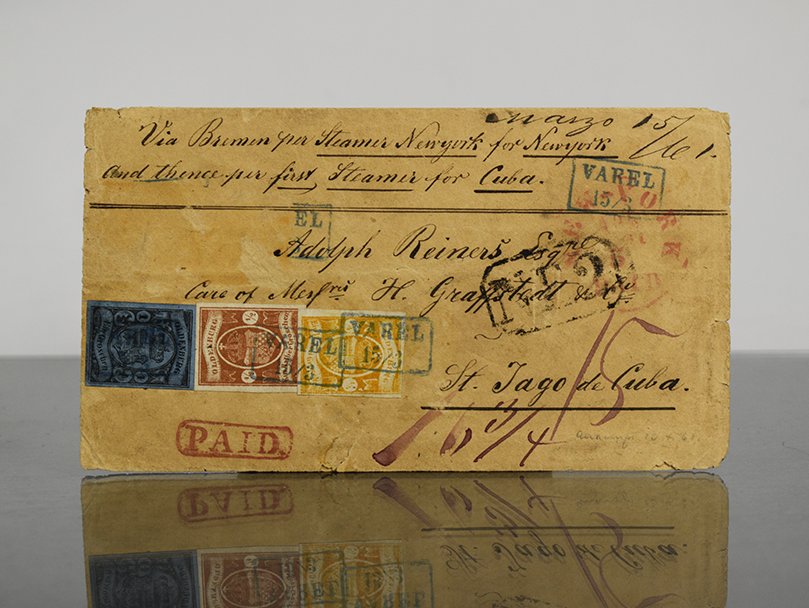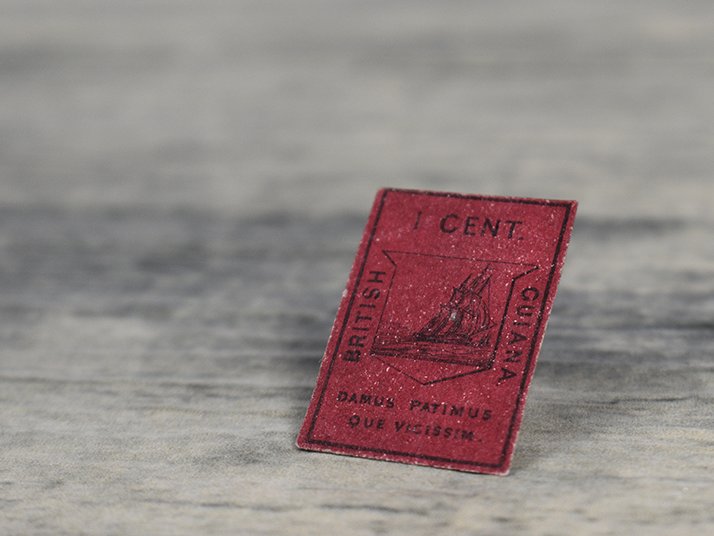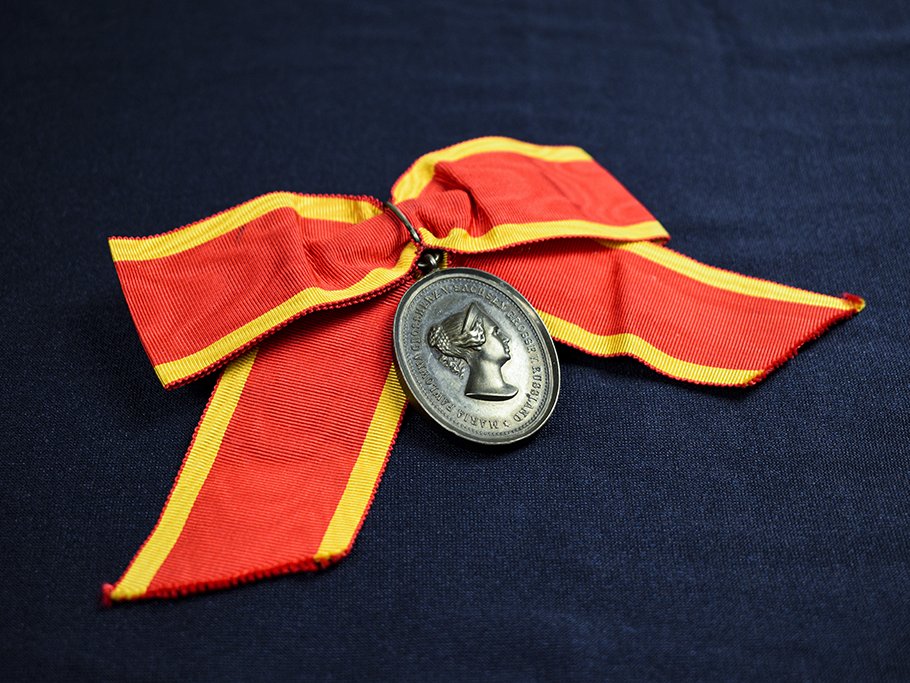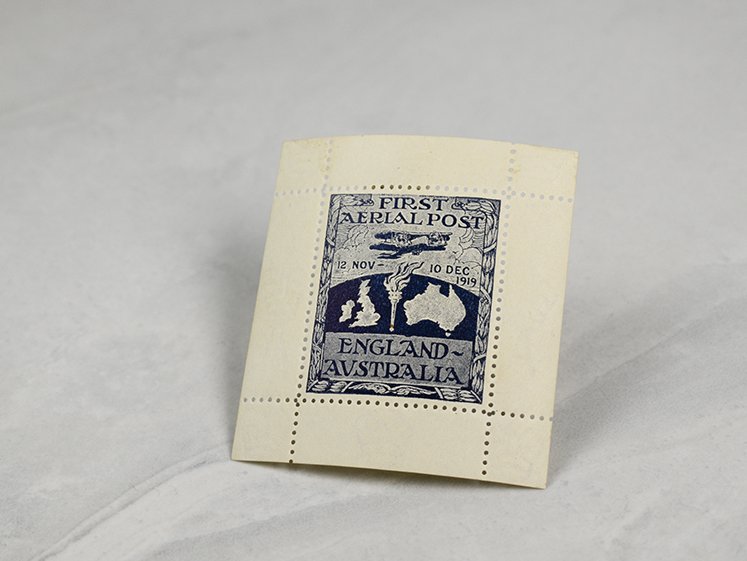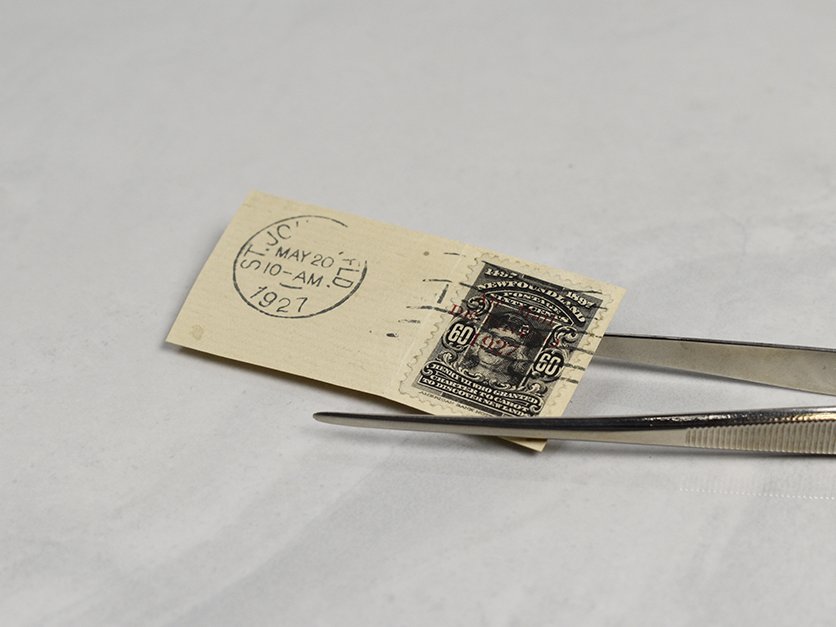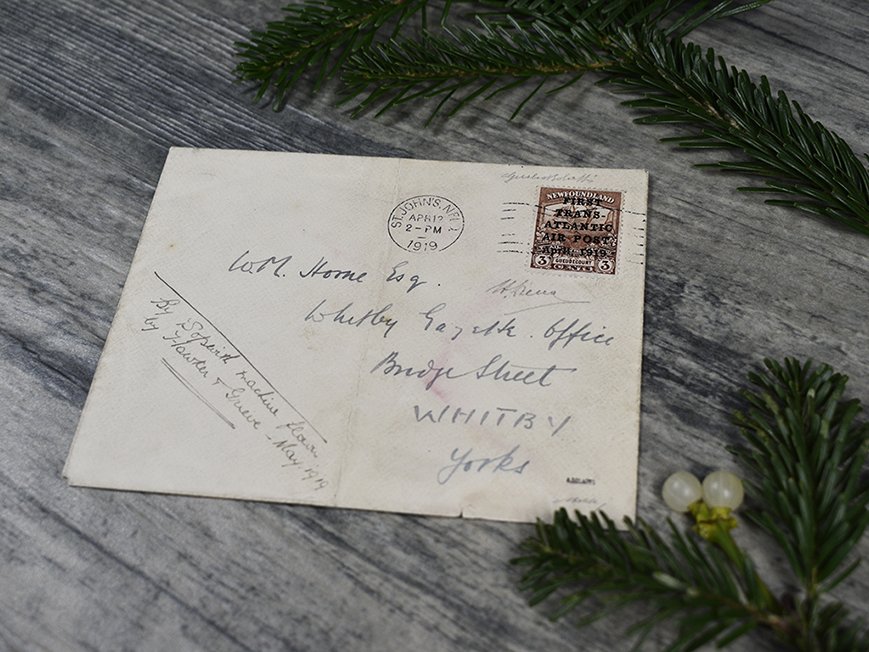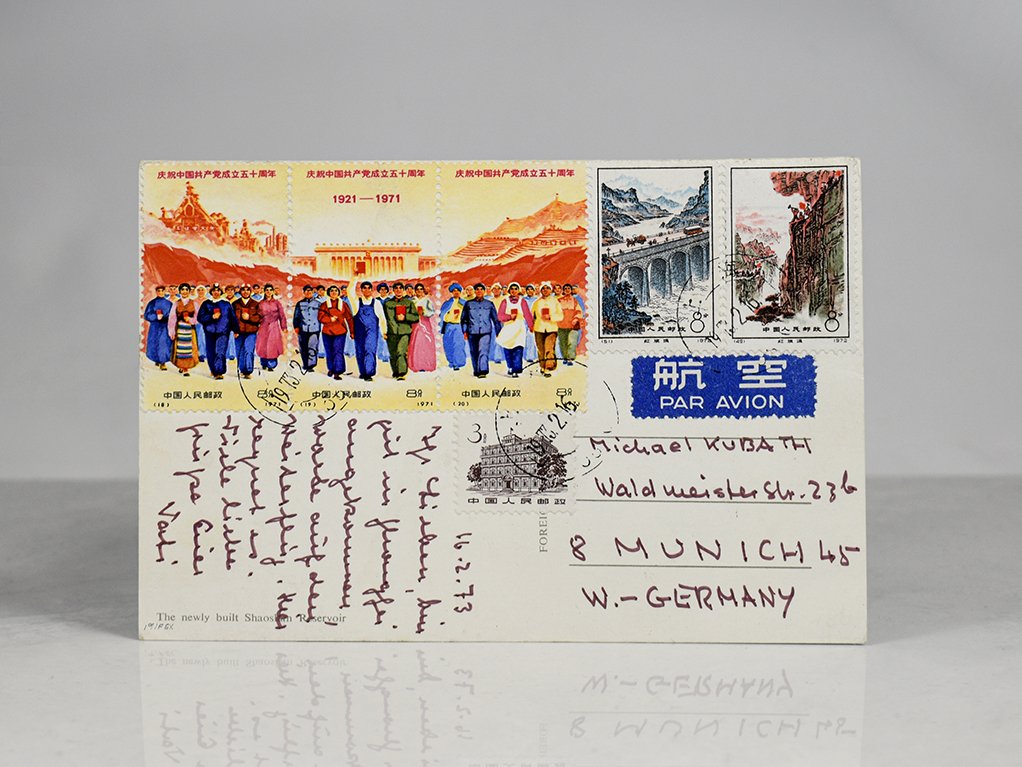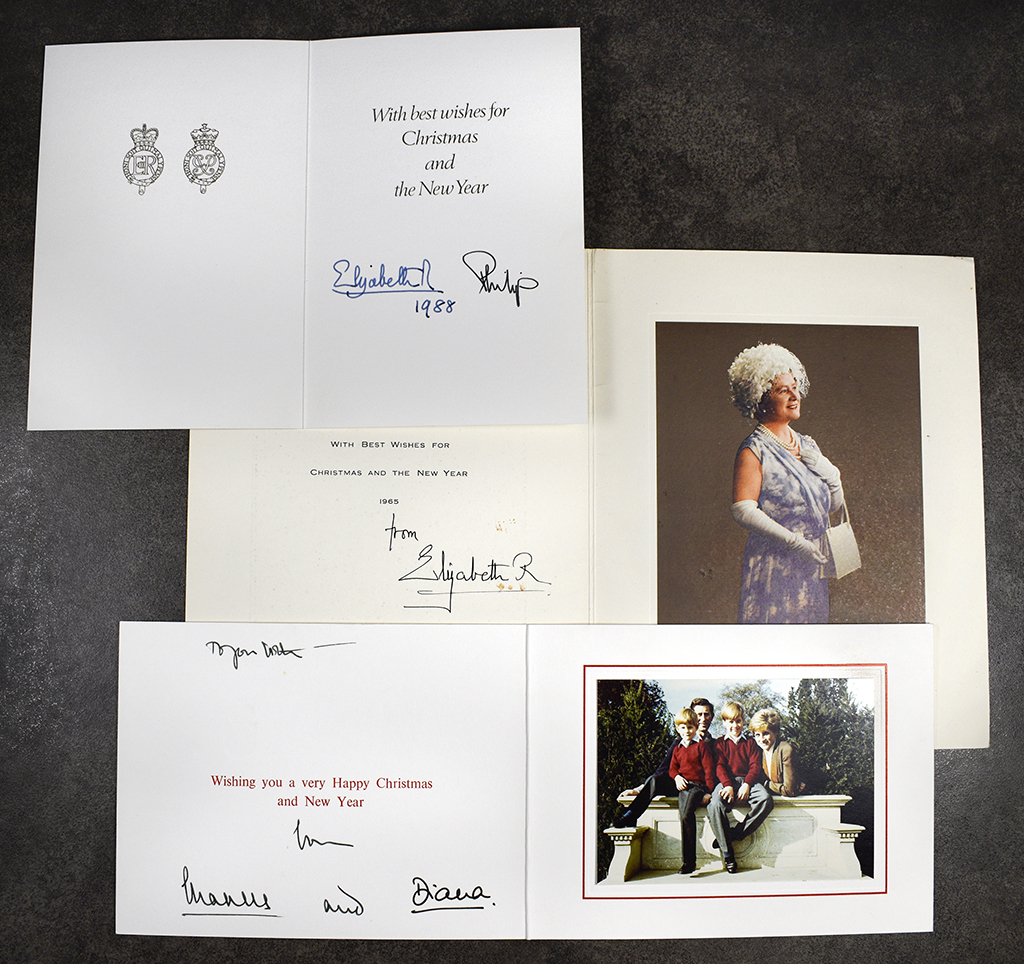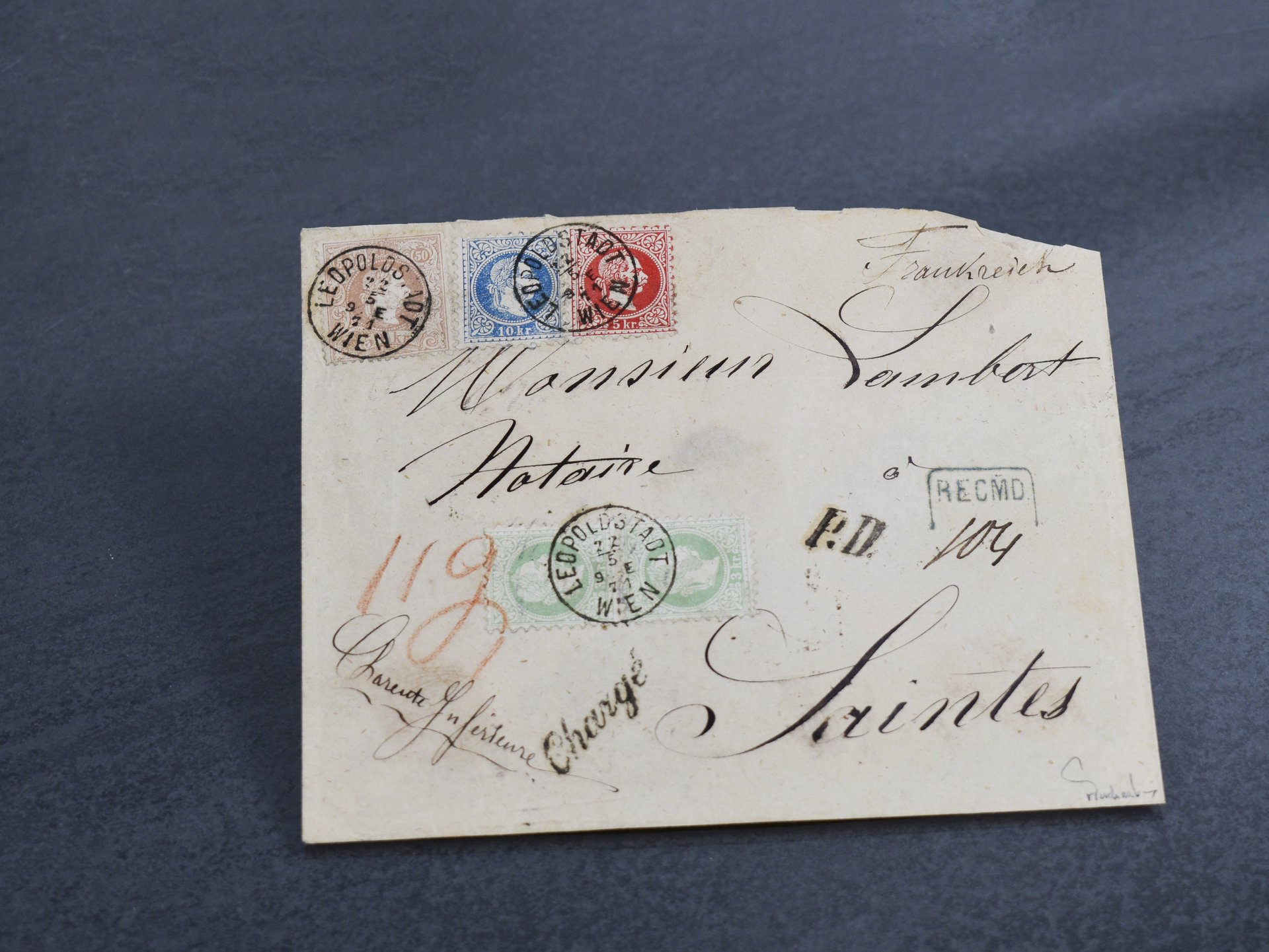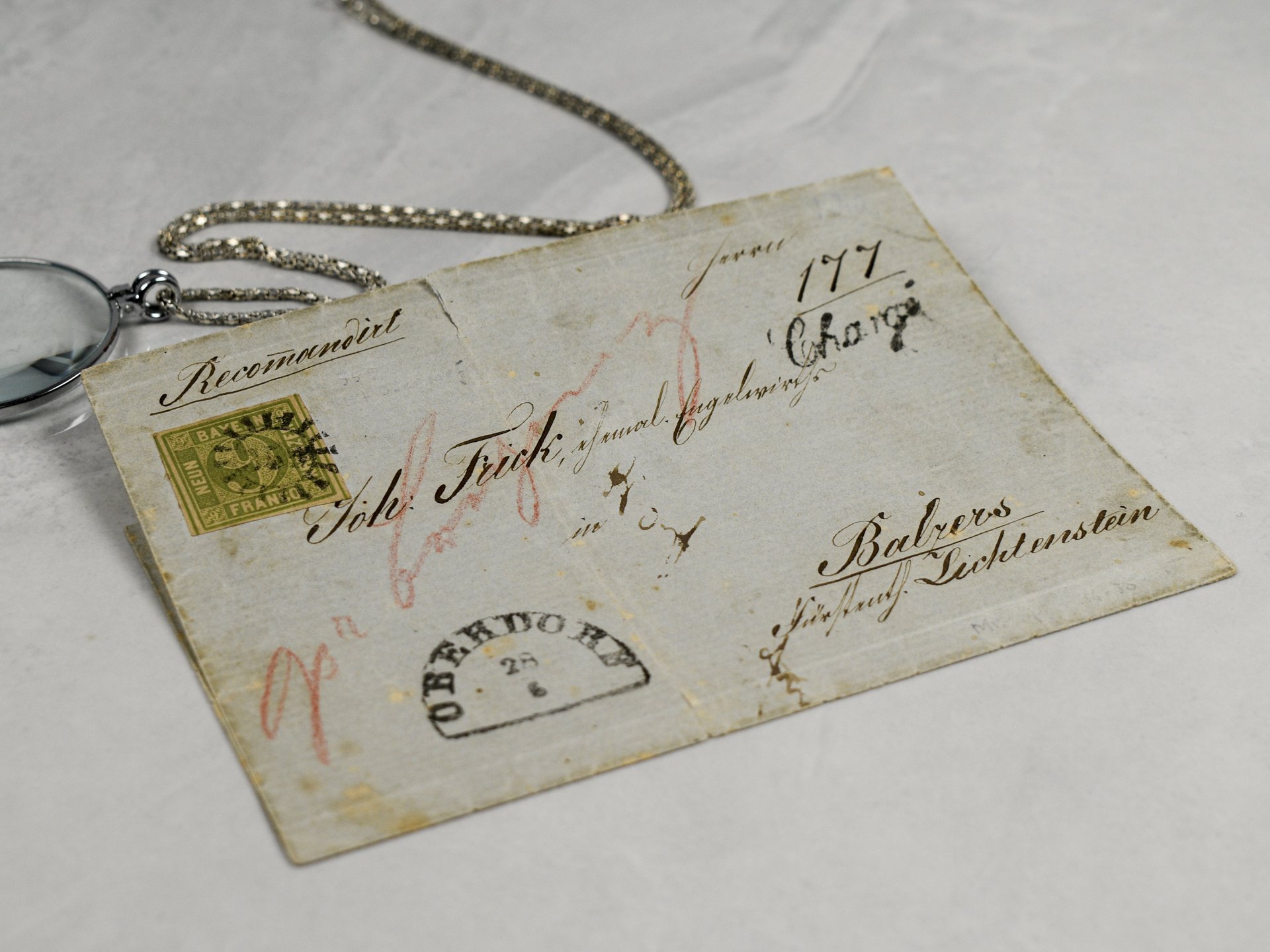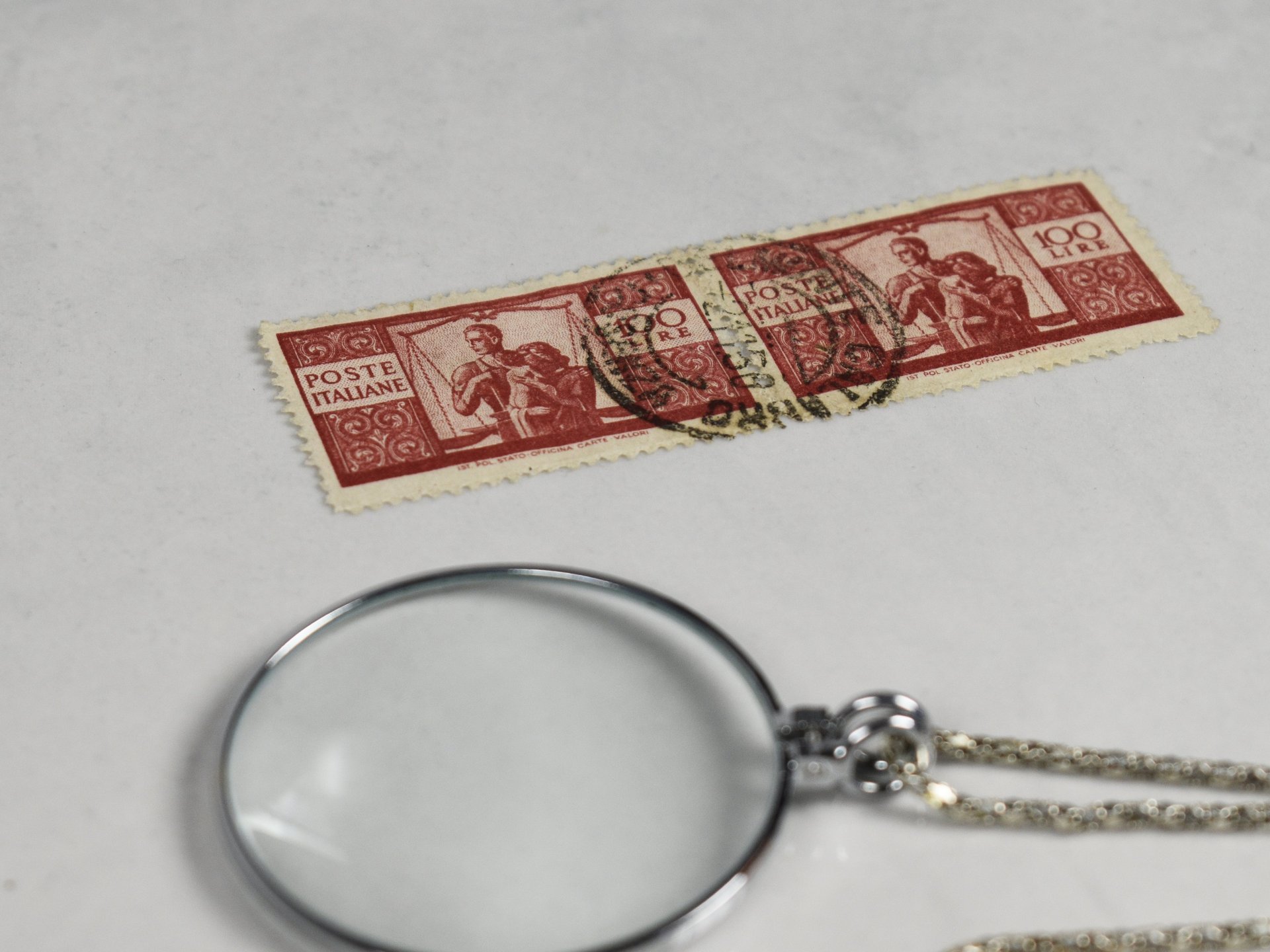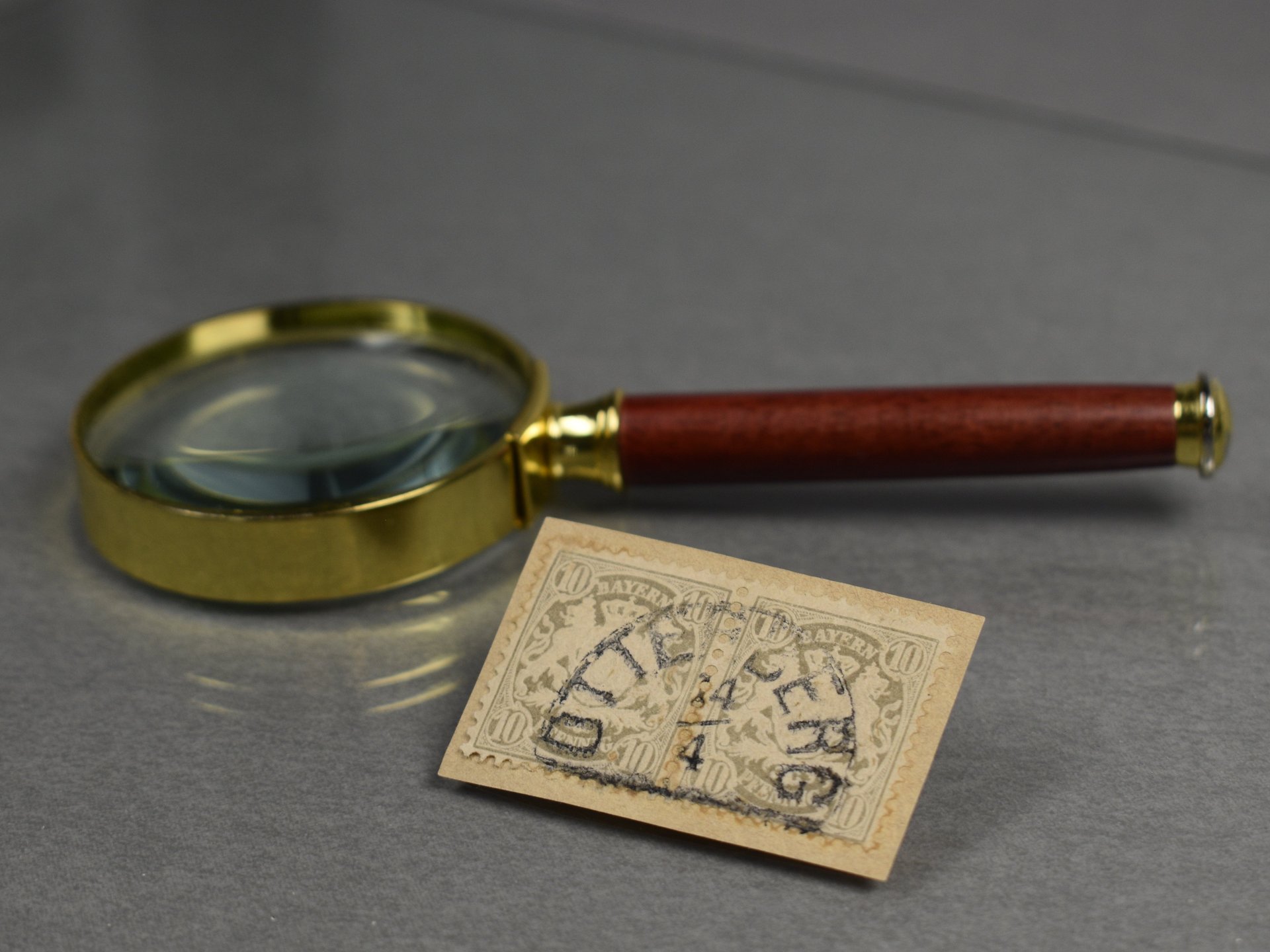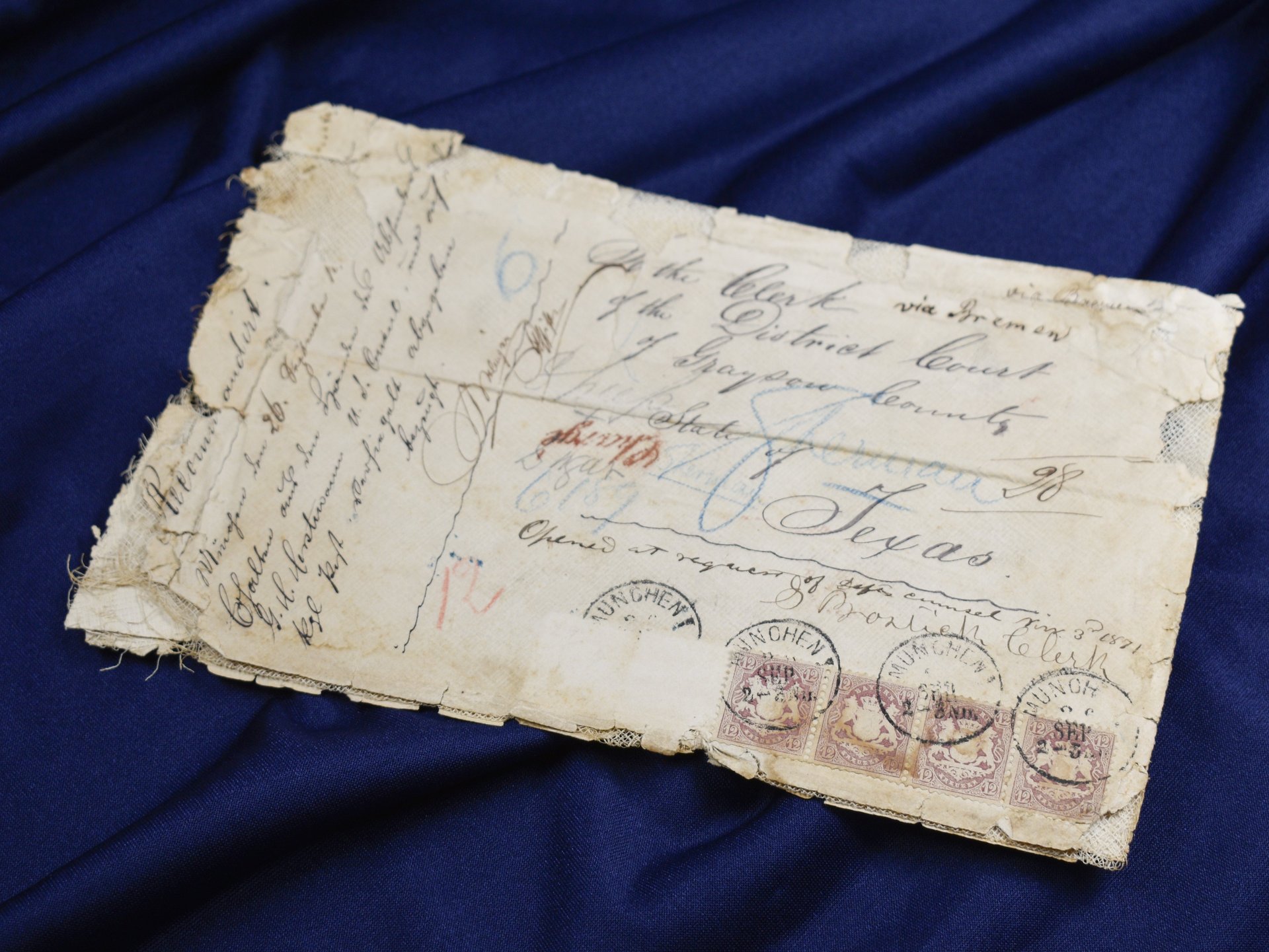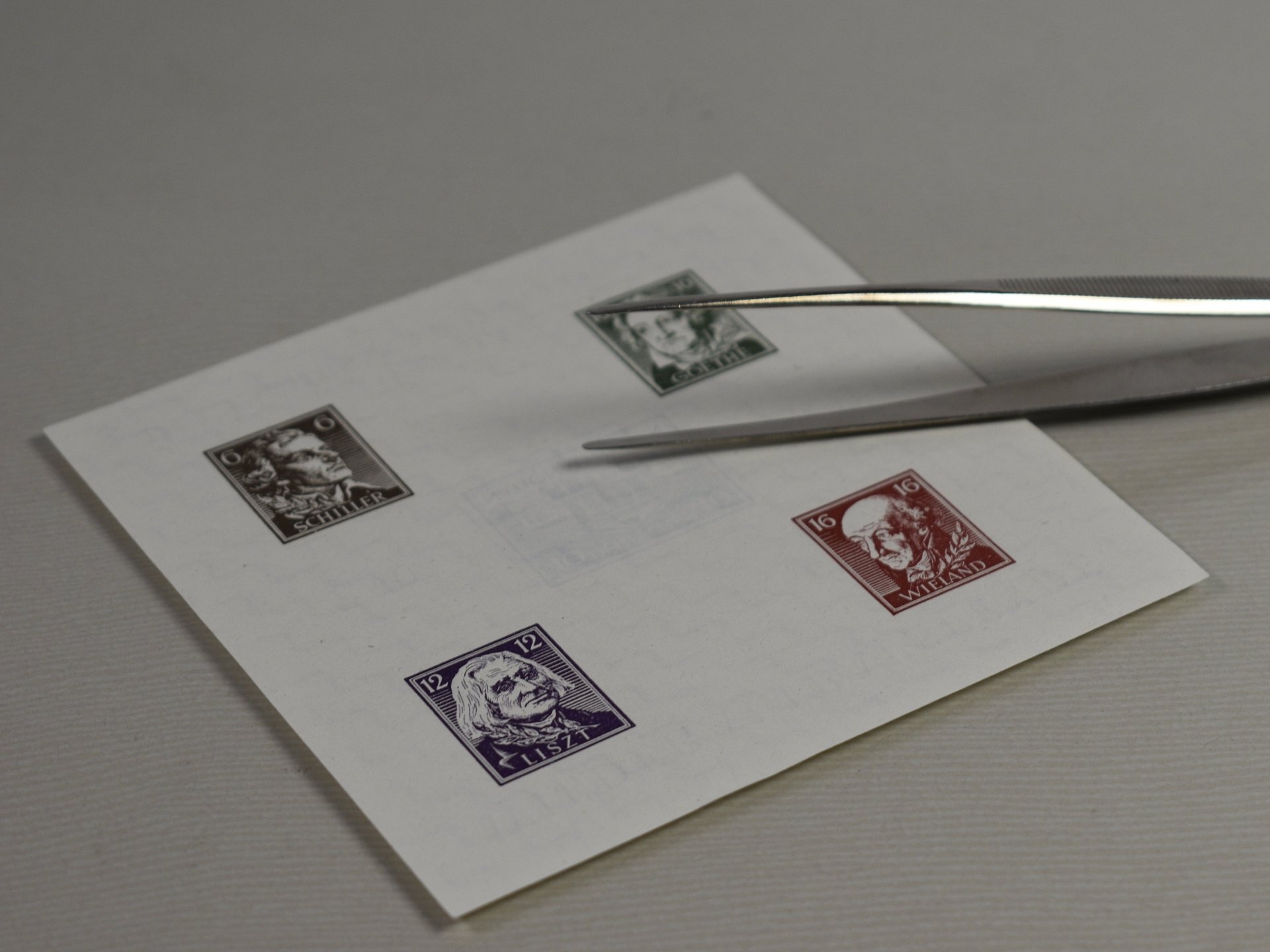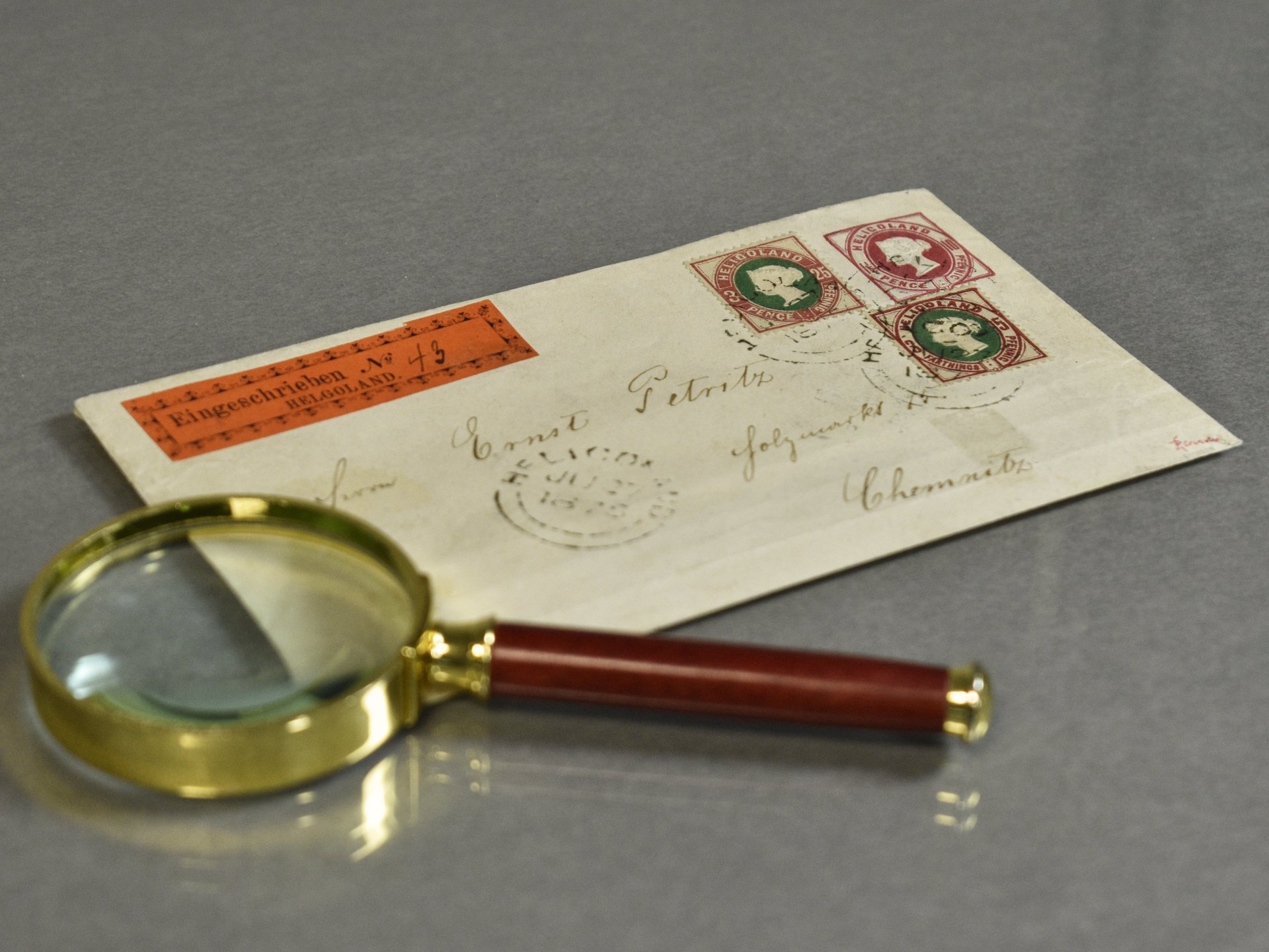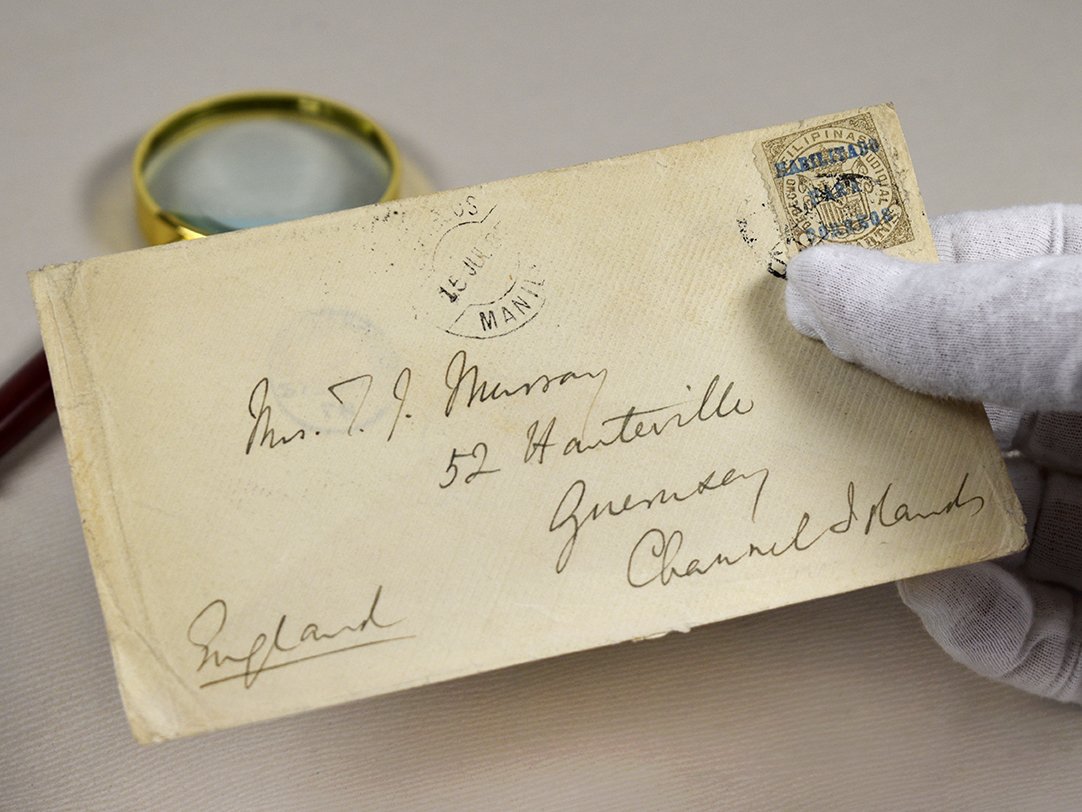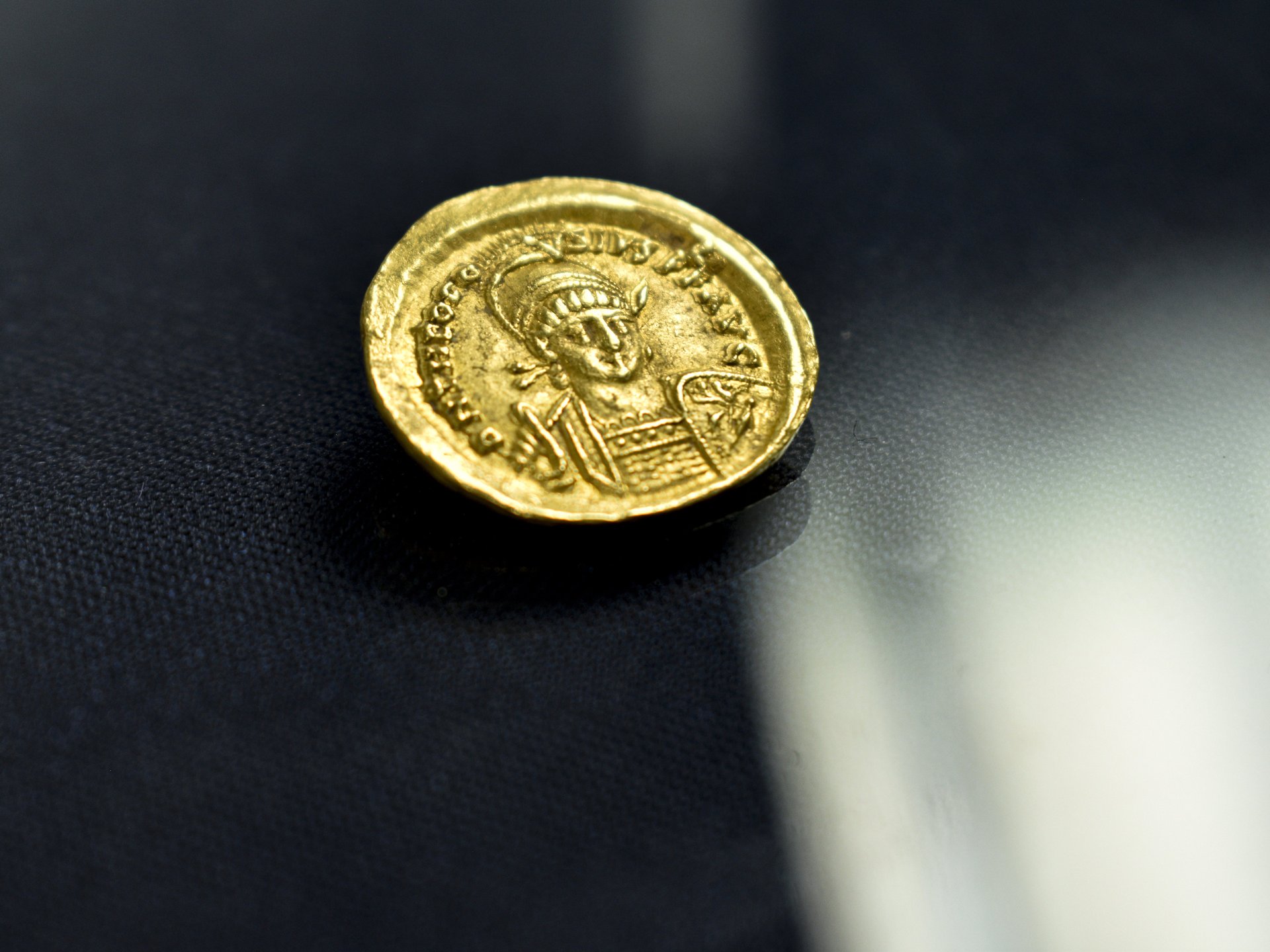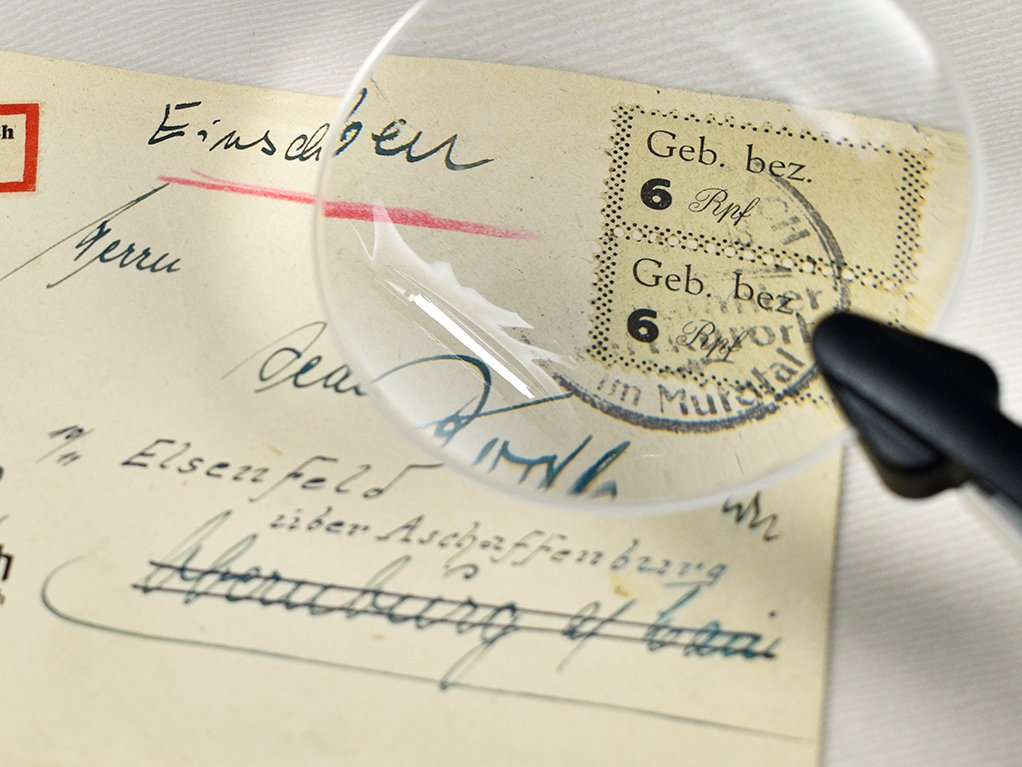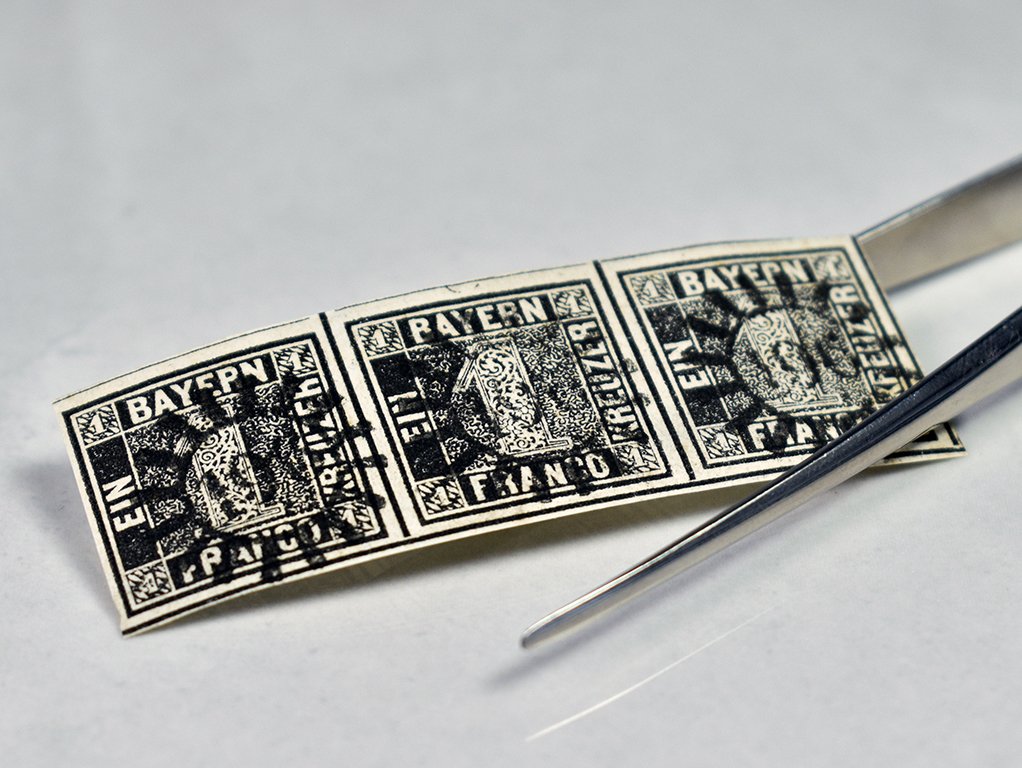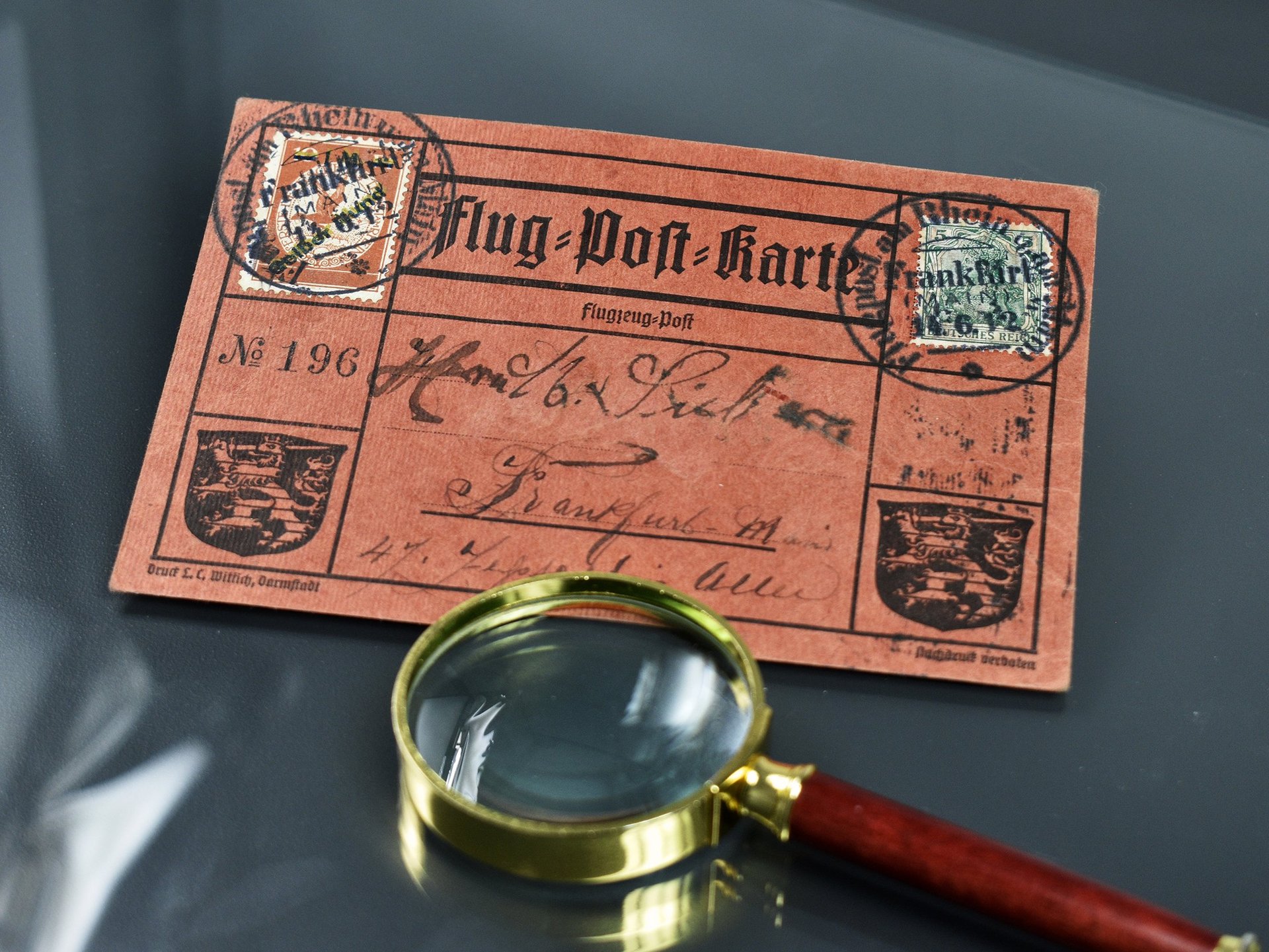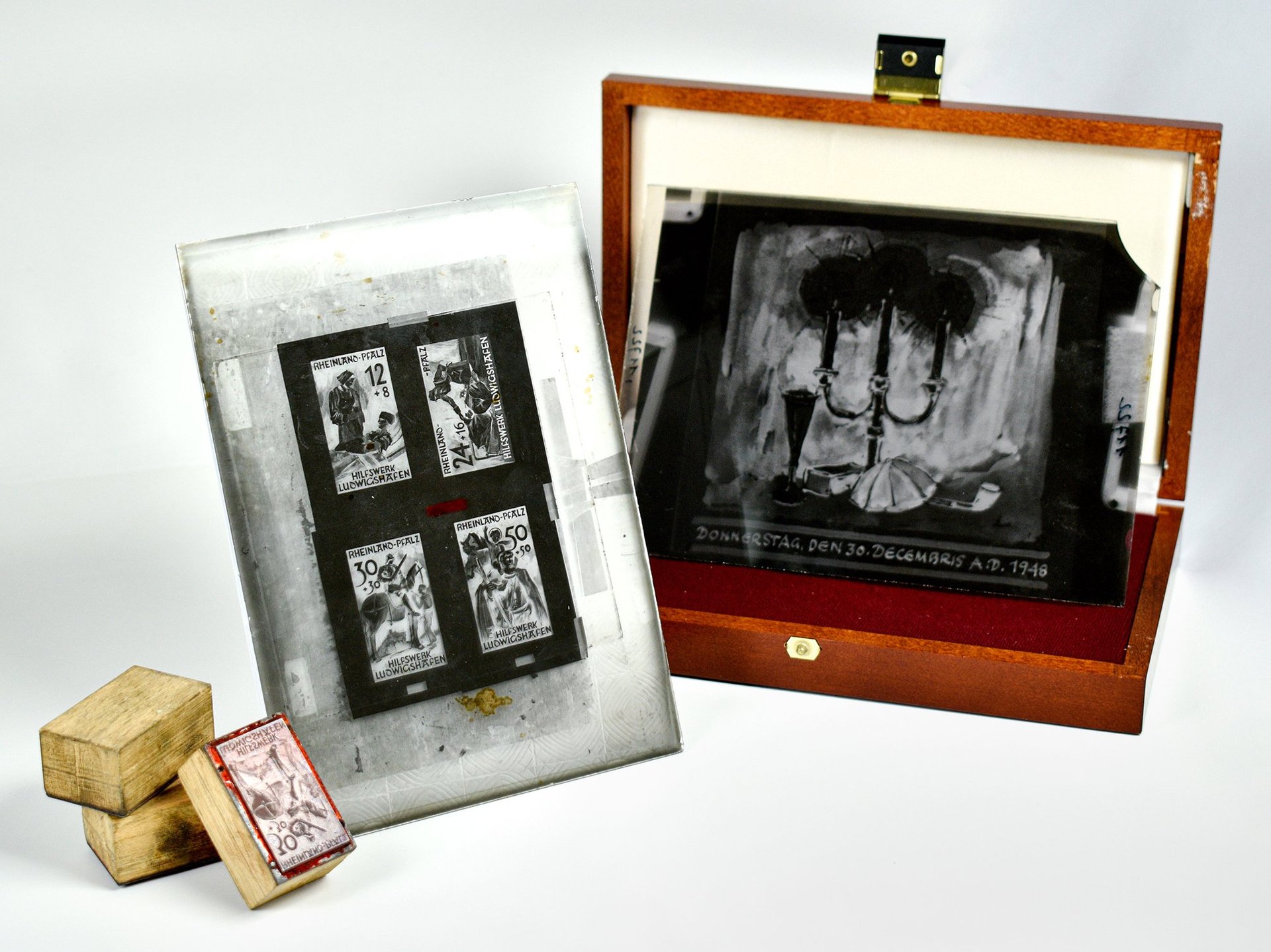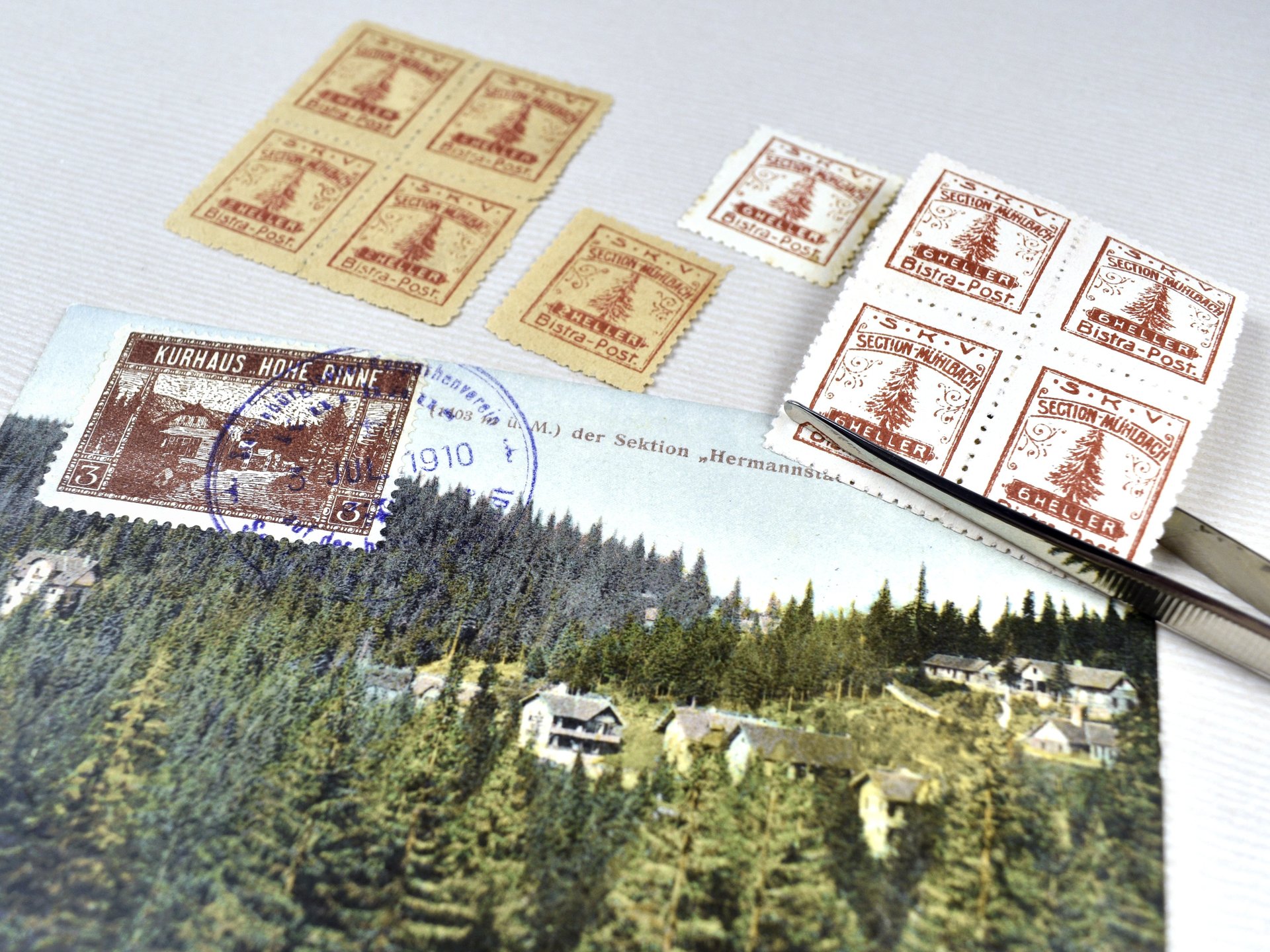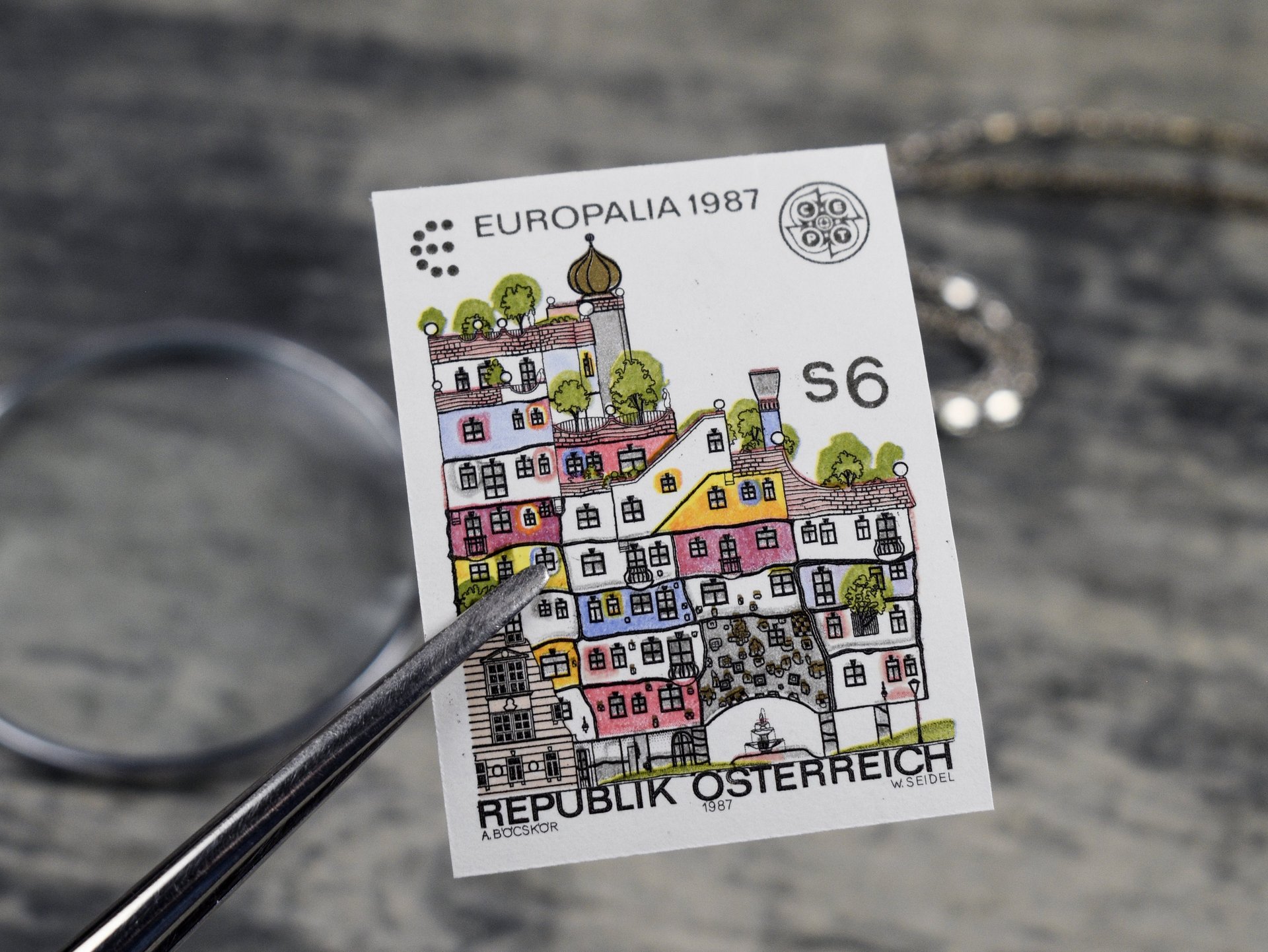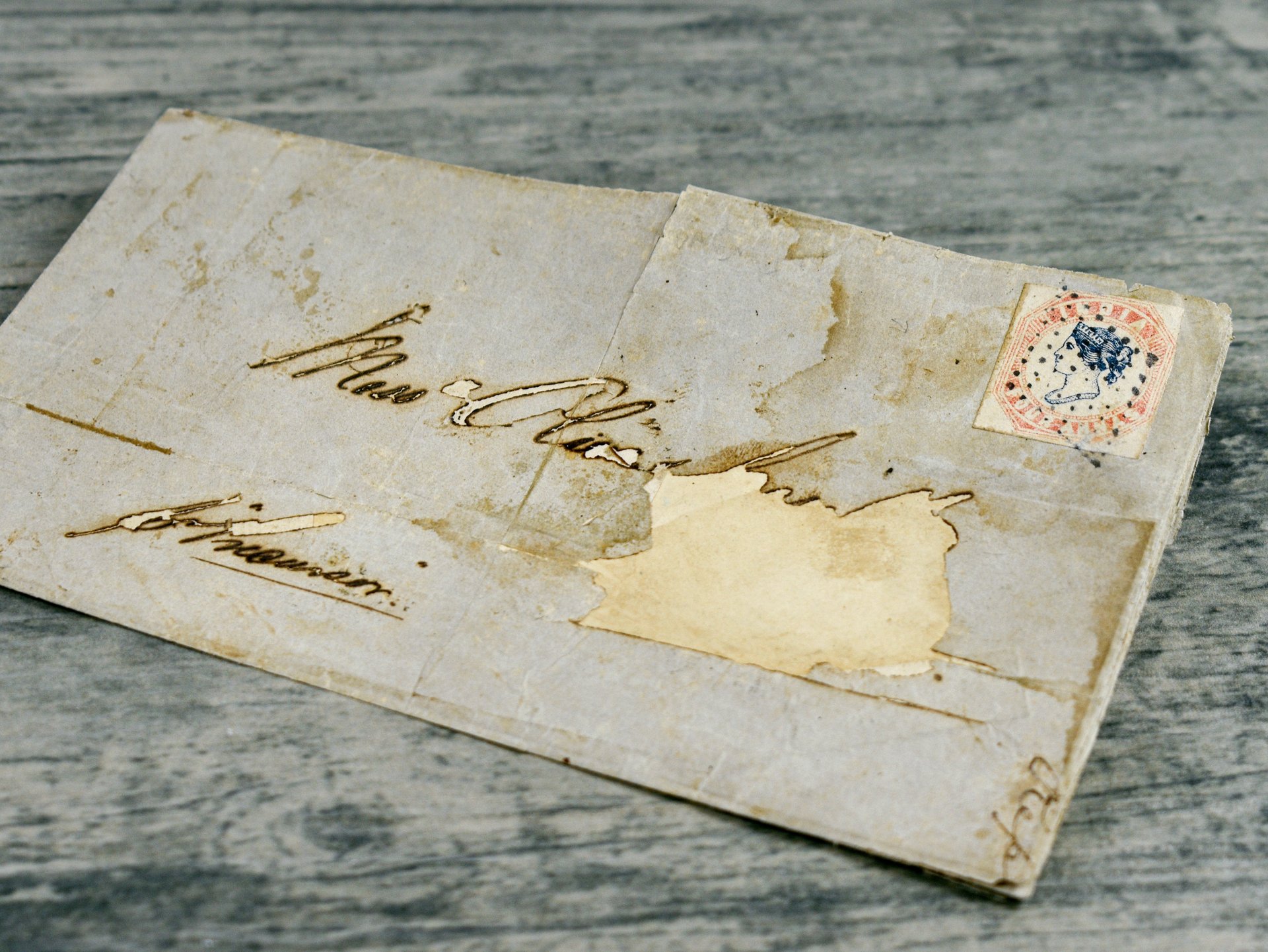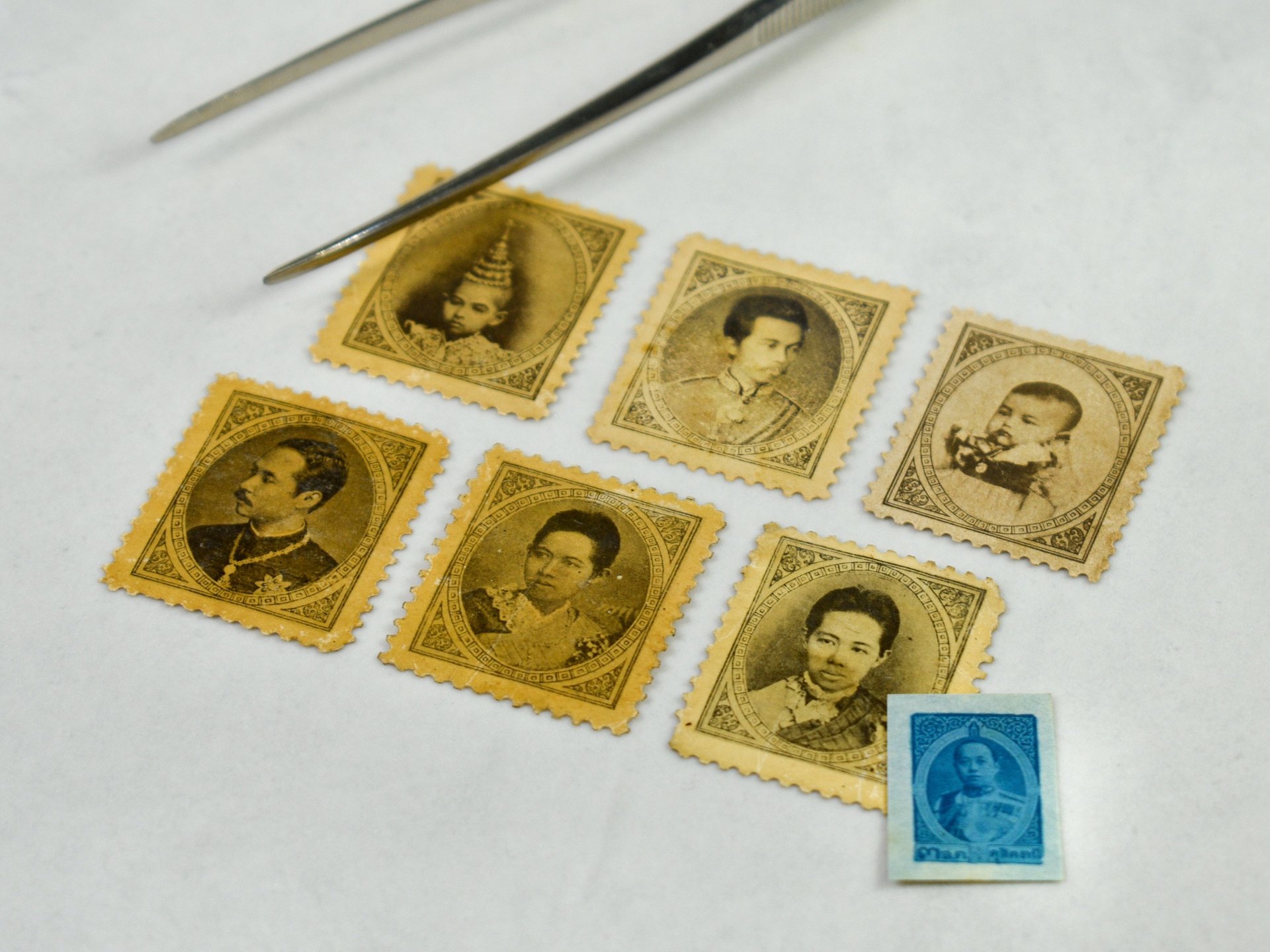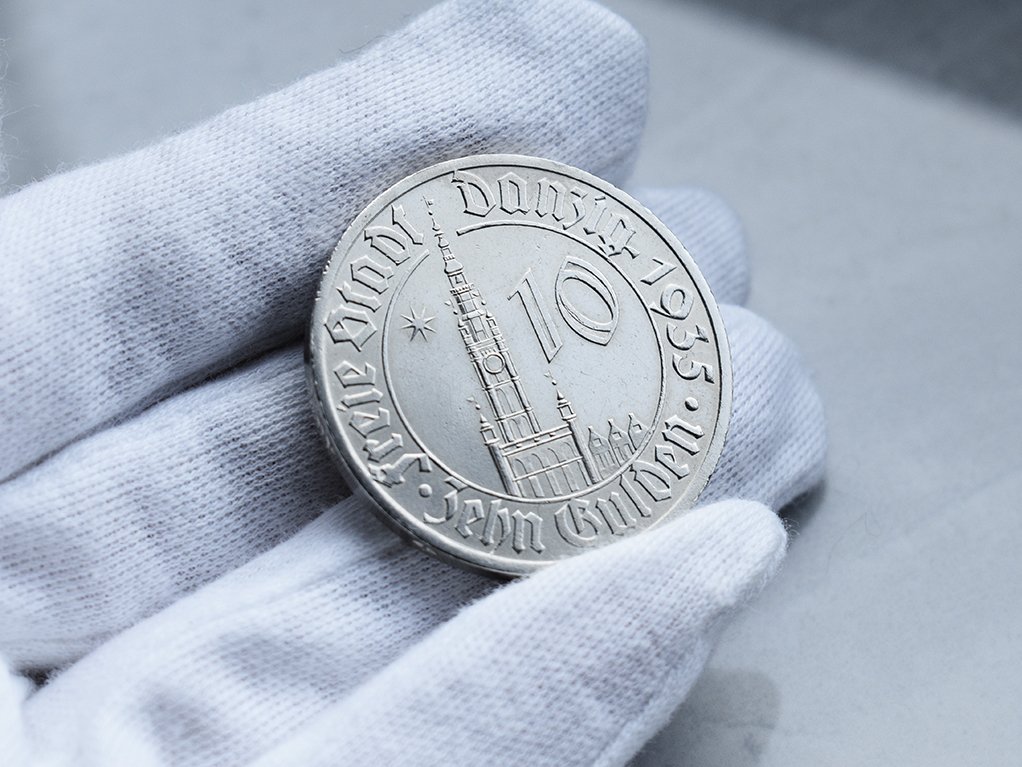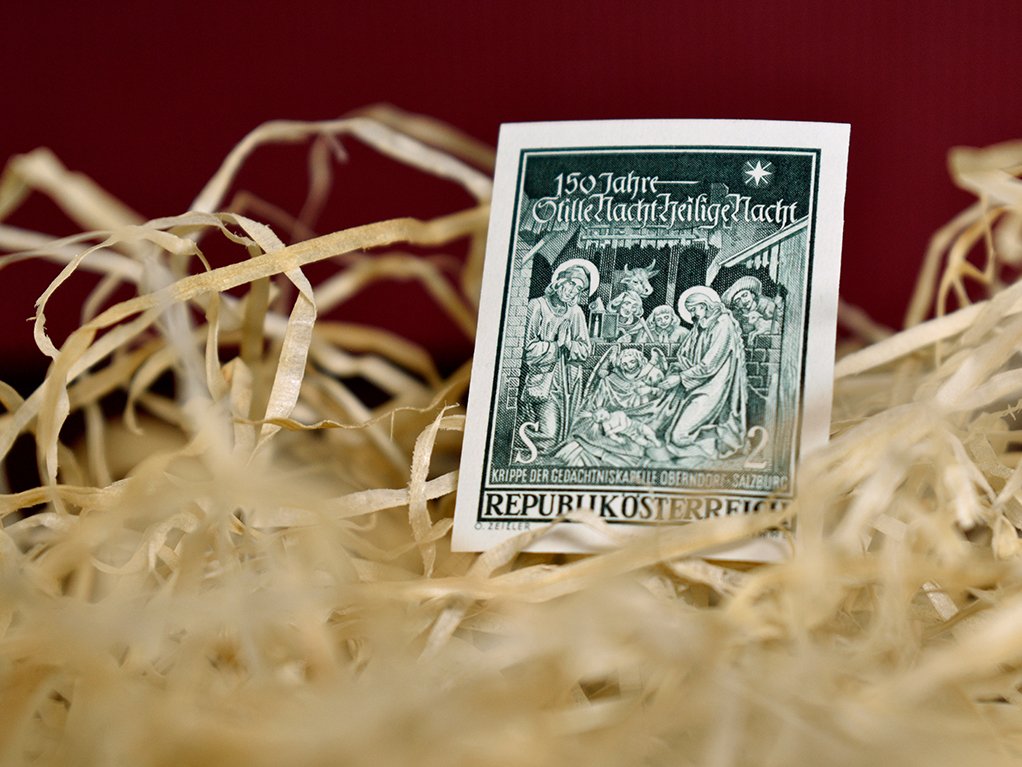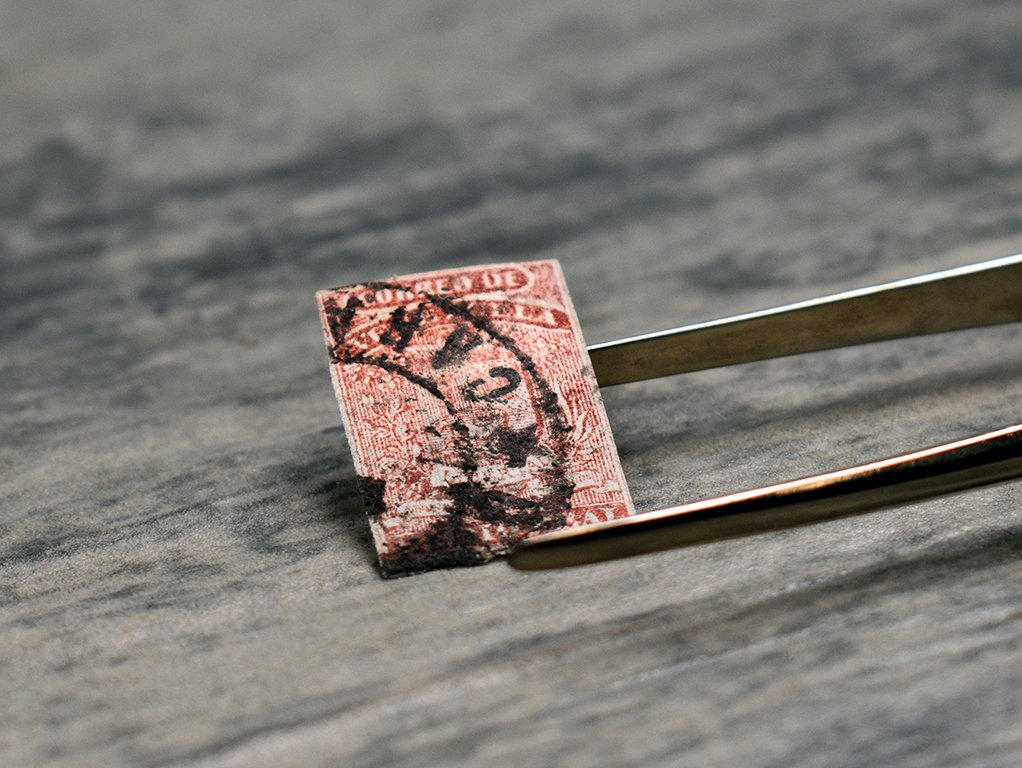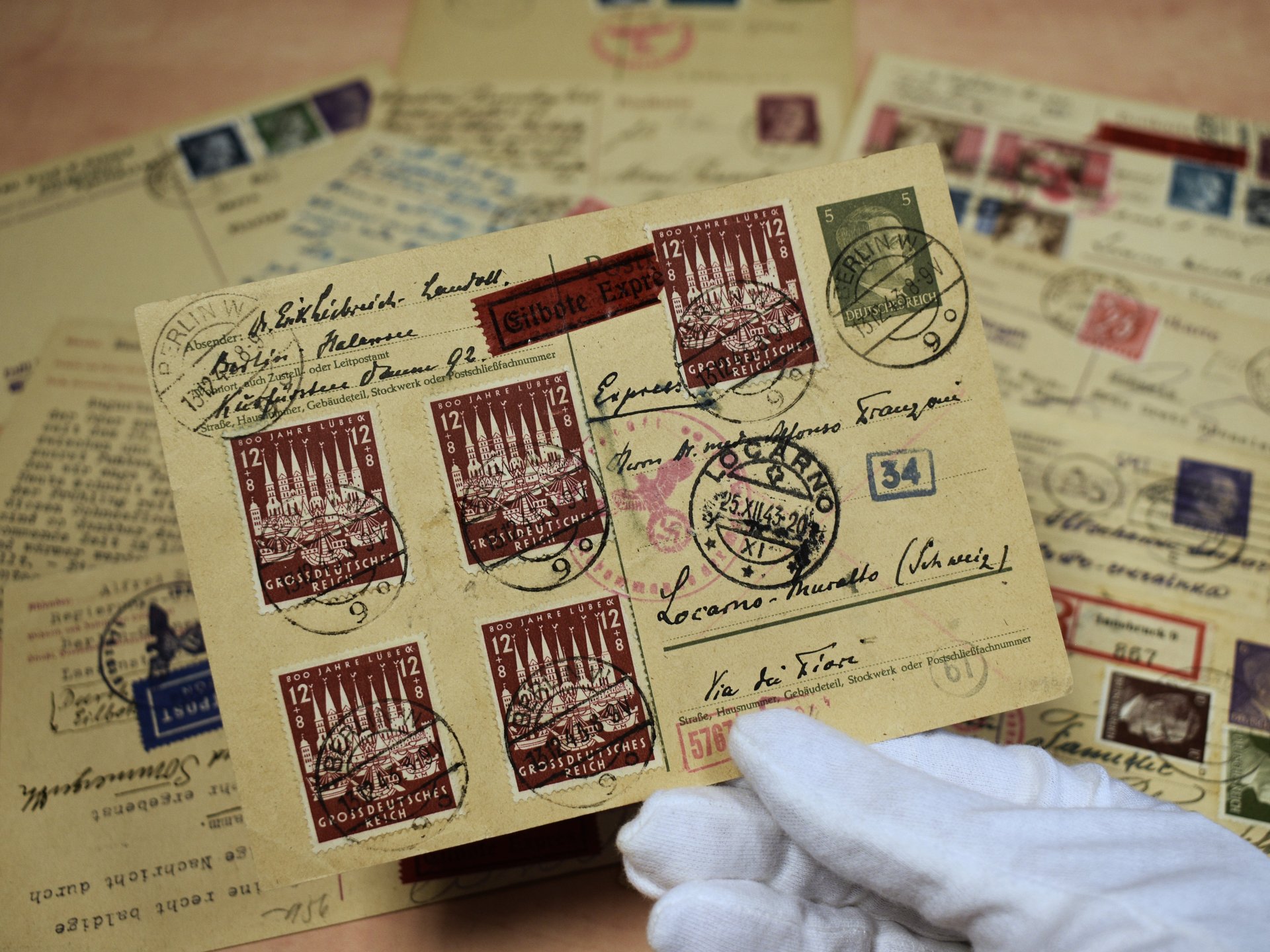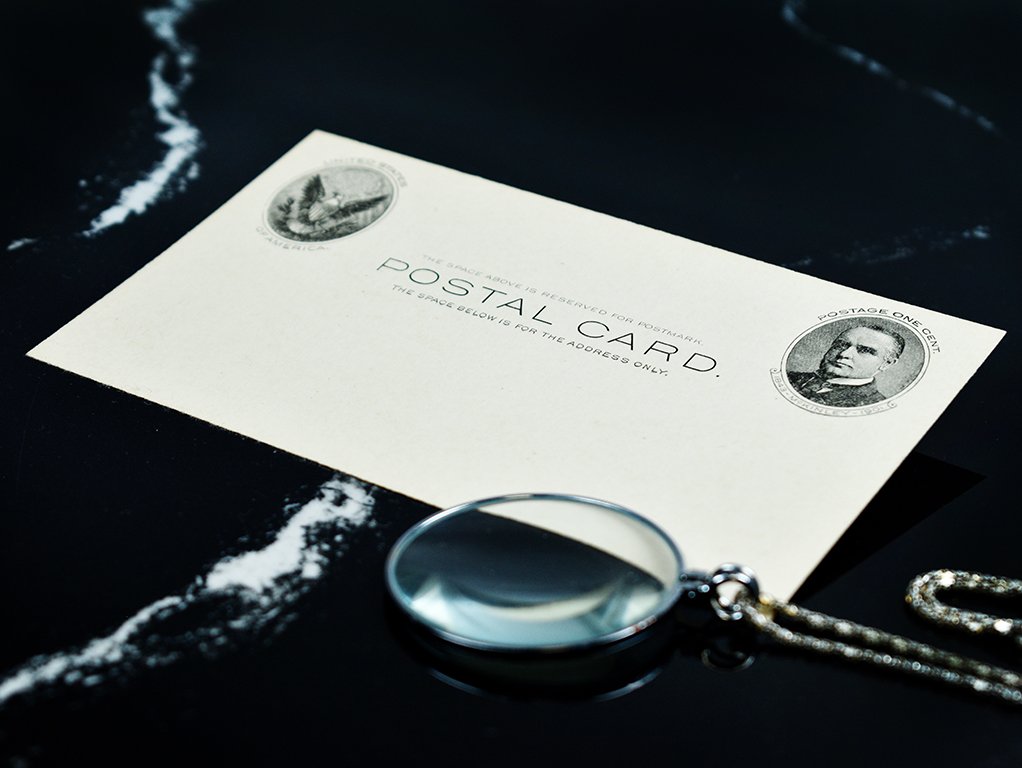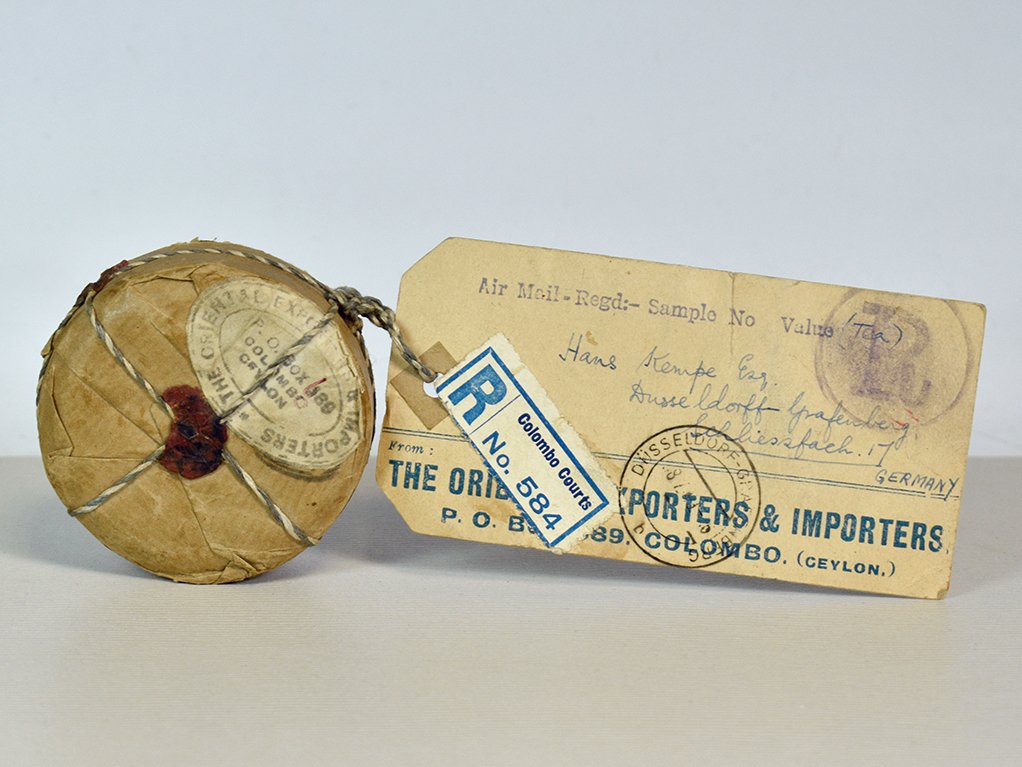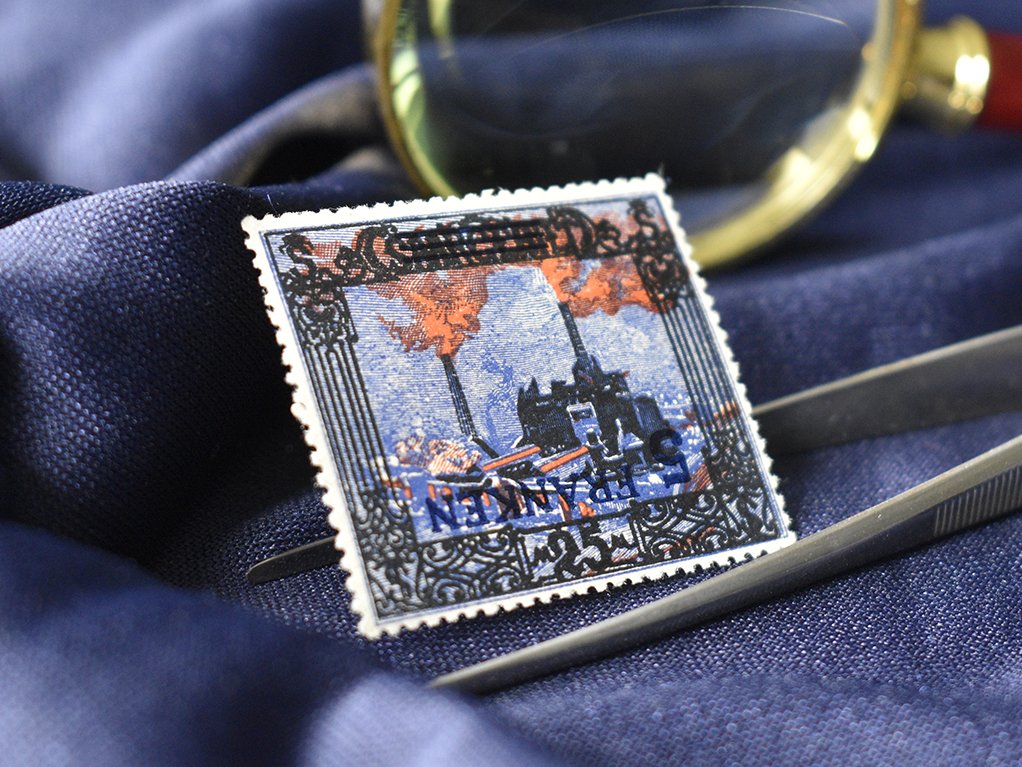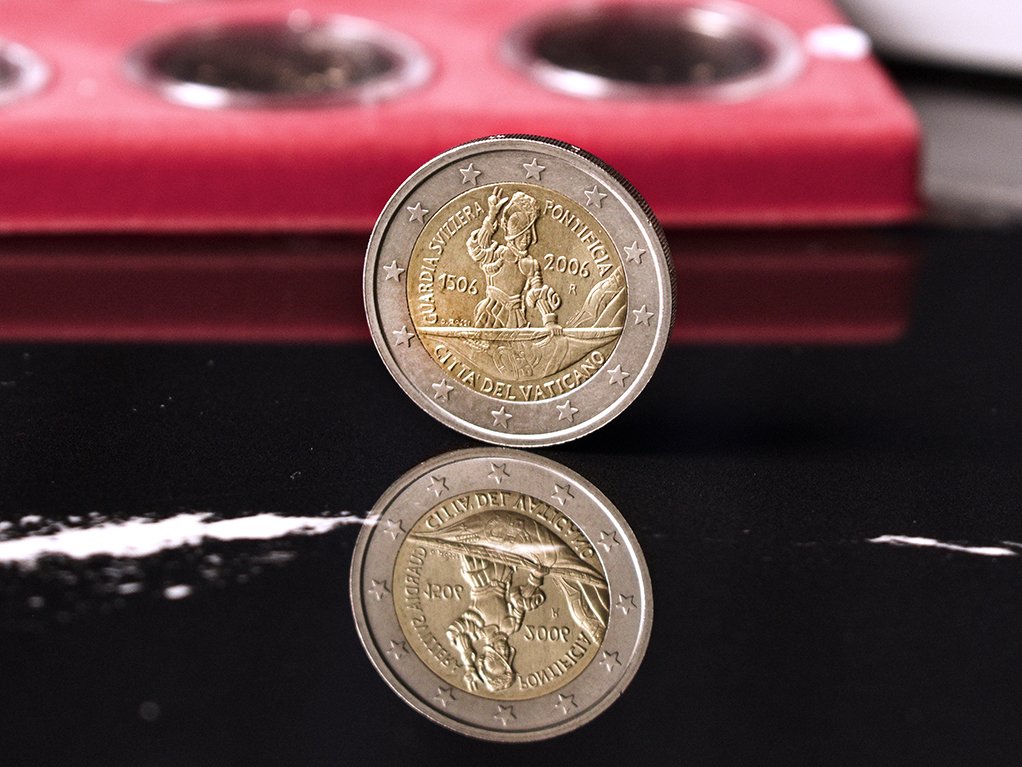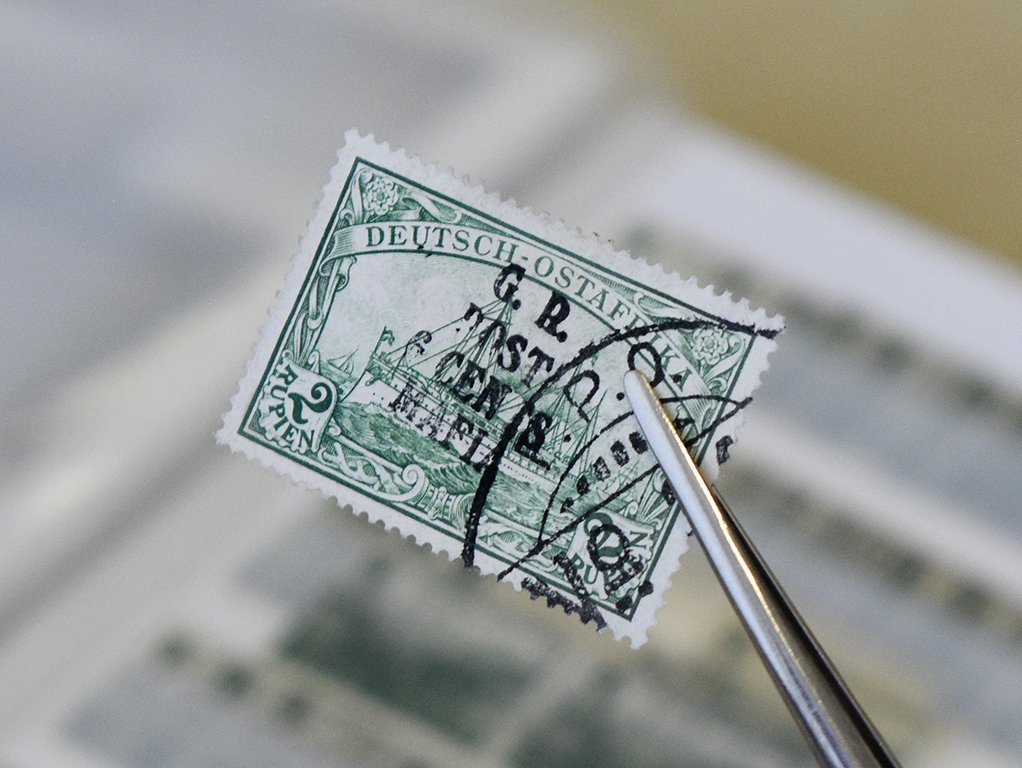Our Favourite Lot of the Week
Lot 2477 from our 56th Auction.
This was written by the famous Belgian stamp pioneer J.B. Moens (1833-1908) in the stamp magazine "Le Timbre-Poste". Moens went even further with "expletives", not without adding: "The ugliness, however, speaks for authenticity and gives it a local character. We would not be averse to giving it the status of a genuine stamp".
So much for Moens' contemporary statements. Joaquim Leote refers to this in his e-book "The Native Stamps of Portuguese India" published in 2006 and continues: "Time has confirmed Moens' prophecy, because the "NATIVES OF INDIA", despite or perhaps
because they are ugly, are among the most sought-after pieces in philately. In fact, the first stamps of Portuguese India, with their simple design, the value in the center, the oval band and the inscriptions, are simple but fascinating, especially when one considers that the dies were recut several times and different types of paper were used for printing.
Reverse prints (TÊTE-BÊCHE) are absolute rarities of these issues. We are proud to offer such a piece in our 56th auction under lot number 2477. Only 7 pieces are known to exist.
Leprosy is one of the oldest known bacterial diseases. The Norwegian Gerhard Armauer Hansen discovered it in 1873. Full scientific recognition of Hansen's achievements came in 1909 at the "Second International Scientific Leprosy Conference" in Bergen, Norway.
While some of this week's lots have an obvious philatelic feature, here a rather unimpressive detail makes this card special. These are the two purple postmarks: the gray, rather inconspicuous 30 öre stamp has a Norwegian field postmark, and the red express stamp has a second postmark with the name, place and date of the conference in French. Finally, we have a rather early special postmark from a rather early special post office.
This postcard speaks for the confidence in international or European postal and transportation connections. Here a conference participant writes on a THURSDAY from the west coast of Norway to the southeast of Germany that he would like to be picked up at the train station on Monday morning at 2 o'clock. Today, this postcard would not arrive in time even by courier. Our sender must have had his doubts, because he has instructed that nothing is to be delivered at night. All in all, a remarkable gem that tells a lot beyond the special postmark. And we have not even mentioned the "greatest desire" of the card writer.
The Duchy of Oldenburg (Grand Duchy from 1815) had tobacco factories but virtually no tobacco growing. However, there was a great demand for snuff, chewing tobacco and especially cigars. The tobacco leaves had to be sourced mainly from overseas, not least from Cuba. This, of course, delighted philatelists because orders to Cuba required correspondence, i.e. covers, especially those with stamp franking. But there was a problem: a cover to Cuba sometimes cost 6 ¾ groschen (which was ultimately due to the fact that the conversion of postage from foreign currencies also
involved quarter fractions of a groschen). By 1860, however, there were no stamps in the ¼ groschen denomination. Apart from partial cash franking, the only option was to issue stamps in this denomination, which was done in 1861. In fact, only a few foreign letters required an additional ¼ groschen franking, which makes this stamp an exceptional rarity in used condition and especially on the cover. In our 55th auction, we can offer a cover with such a stamp under lot number 5100.
It is a unique cover to Miss Rose on the Blankenburg plantation in Demerara, franked with a pair of primitive 4c first issue British Guyana stamps. Because of their unusual appearance, they are known in British parlance as "cottonreels". Indeed, these stamps strongly resemble the labels on wooden spools of thread. The British colony also produced other world-famous stamps, most notably the 1c magenta issued in 1850, which, to the best of our knowledge, exists only once
and was last auctioned in 2014 for $9.5 million. Both the Miss Rose cover and the 1c magenta cover have been the subject of a number of adventurous stories, the truth of which cannot always be verified. Unfortunately, we cannot offer the world rarities described here at our 55th auction. Instead, we offer a 1c black on magenta stamp from the 1852 issue in unused condition - a rare and desirable piece for collectors of this British colony in South America.
Did bourgeois nationalism in Wilhelmine Germany displace women? At least not in the care of the wounded and sick. For this purpose, the Vaterländische Frauenverein and the Frauenvereine vom Roten Kreuz were founded in the German Empire at the end of the 19th century. While the Central Committee, the men's counterpart to the newly founded women's associations, initially focused exclusively on helping in times of war, the women's association immediately included tasks in times of peace, especially in the fields of health and welfare. In this way, women were given tasks that were not unimportant for the existence of the nation-state and gave their actions a
state-supporting meaning. In the broadest sense, these associations were the counterparts to the male heroes of the time.
Of course, special recognition was given to the heroic deeds of women - with a badge of honor donated by Grand Duke Carl Alexander of Saxe-Weimar in three divisions. The first, with the imprint of Grand Duchess Maria Pavlovna, was awarded for 20 years of membership, the second division for 30 years, and the third for 40 years of patriotism and charity. We are delighted to be able to offer a first division medal in the forthcoming auction.
2023 – Week 3
A Vickers Vimy, G-EAOU (nicknamed curiously "God 'elp all of us") landed on bamboo mats and the pilots were knighted
On 12 November 1919, Captain Ross Smith, together with his crew, M. Smith (his brother and co-pilot), W.H. Shiers and J.M. Bennet, started from Hounslow Heath (London). After stops in Lyon, Rome, Cairo, Damascus, Basra, Karachi, Dehli, Calcutta, Akyab, Rangoon and other stations to Surabaya, where the aircraft stuck on a provisional airstrip made of bamboo mats. The flight continued from there to its destination of Darwin (Northern Territory Australia), landing on 10 December 1919. The total flight time was 135 hours and 55 minutes, and the total flight distance was
almost 18,000 kilometers. The prize money was shared by the crew. The Smith brothers were knighted for their heroic deed. The Australian government issued an additional cinderella for this flight with the inscription FIRST AERIAL POST/ENGLAND-AUSTRALIA. This was affixed to 320 items carried after arrival in Australia.
One of such vignettes in souvenir sheet form in mint condition can be found in our 55th auction. One more highlight from our special airmail catalog.
Marquis Francesco de Pinedo (1890-1933) was a famous Italian pilot. In February 1927, De Pinedo and his co-pilot Carlo del Prete started in Sardinia for their flight "Four Continents". In May 1927, they were on the final leg of this flight from Newfoundland to Italy in their seaplane "Santa Maria II". The government of Newfoundland asked De Pinedo to take a mailbag to Italy. He agreed - an overprint stamp was quickly issued. On the flight, however, there were engine problems and the plane had to make an emergency
landing in the Atlantic. The pilots were rescued and the plane was towed to the Azores. After repairs, the flight could be continued and the journey finally ended on 1 June 1927 with the landing in the port of Ostia. Of the above stamp with the red overprint "Air Mail/DE PINEDO/1927" 300 pieces were issued, 230 of them were used for correspondence.
We are pleased to auction a stamp with this extremely rare stamp in our 55th auction - another highlight from our special airmail catalog.
Lt. Harry George Hawker, former chief test pilot of the Sopwith Aviation Company, and his navigator Lt. Cmdr. Kenneth McKenzie Grieve were the first in 1919 to try to win the £10,000 prize offered back in 1913 for the first pilot to complete a transatlantic flight in less than 72 hours. The flight from Newfoundland to Ireland was associated with all sorts of difficulties and eventually the pilots landed in the Atlantic near the Danish steamer "Mary" whose crew rescued them. At this point they were 1,150 miles from Newfoundland and 750 miles from Ireland. The "Mary" was not equipped witha radio, so the rescue did not reach the rest of the
world immediately. Fearing that the men had not survived, King George V sent a telegram of condolence. A bit premature. Later, Hawker and Grieve were received at Buckingham Palace, where they were both awarded the Air Force Cross for bravery.
We are proud to offer in our 55th auction as part of the special catalog "Wolfgang Schneider Collection" a cover with a 3c stamp of Newfoundland, overprinted "FIRST/TRANS-/ATLANTIC/AIR POST/April, 1919", which the pilots had on board. A very rare piece of pioneer airmail.
At least since Marco Polo's travels, the Middle Kingdom has been a well-known mystery. Barely any other country is the subject of so much writing, research and dreaming here in Central Europe as China. Only little of it contributes to a better understanding of the country, its history and its people.
Every visitor to the country realizes: China is different from what you expect. The writer of this postcard has visited the country and gives us a China-typical mishmash of contradictions: On the one hand a strip of three stamps from the 1971 series “50 years Communist Party” in the typical “socialist realism” style of the Cultural Revolution, showing marching workers and peasants presenting Mao’s little red book. On the other hand two stamps from the series celebrating the completion of the “Red Flag” irrigation canal, in the
style of classical Chinese landscape painting. On the one hand propaganda for a policy that wants to destroy all “ancient culture”, on the other hand exactly this ancient culture.
By 1973, the "terror phase" of the Cultural Revolution was already over, and Nixon's "ping-pong diplomacy" opened up the country a little. However, the Cultural Revolution is not over. It is understandable that in such a situation a Western visitor writes a rather trivial message to his family: "Ihr Lieben, bin gut in Shanghai angekommen, warte auf den Weiterflug. Hier regnet es. Viele liebe Grüße, Euer Vati" (Dear ones, I arrived well in Shanghai, waiting for the connecting flight. It’s raining here. Many greetings, your dad). In the end, this is comforting: It is actually raining in China, too. Not everything is different.
She held the throne longer than any British monarch before - 70 years and 214 days, to be exact - and was the longest reigning head of state in the world. And now she's not supposed to have been Queen of England? No, she was not, per se, because royal titles are complex. Their origins often go back centuries, have political and geographical influences, and are still changed now and then.
To understand the present title of the British monarch, we must look back over 400 years to the then Queen of England. Elizabeth I, who also goes down in history as the Virgin Queen and gives her name to an entire age, remains unmarried and without descendants. After her death in March 1603, the crown passes to her closest relative, the Scottish King James VI, who is the first Stuart ruler to rule both countries - Scotland and England - in personal union. He bears the title King of Scotland as James VI and the title King of England and Ireland as James I. In May 1707, the Act of Union united the two kingdoms to form the Kingdom of Great Britain and replaces the English and Scottish parliaments with the British Parliament. The then reigning Queen Anne is henceforth given the title Queen of Great Britain and Ireland. About 100 years later, Ireland is admitted to political union with Great Britain in 1801, with a large part - except for northern counties - regaining its independence in 1920 under George V. The title of Queen of Great Britain was changed to Queen of Scots. The then changed title, has remained the same to this day and is King/Queen of the United Kingdom of Great Britain and Northern Ireland. The full title of the British monarch in office since September 8, 2022, is:
Charles the Third, by the Grace of God, King of the United Kingdom of Great Britain and Northern Ireland and of His other Realms and Territories, Head of the Commonwealth, Defender of the Faith.
The ordinal numbers following the title take into account rulers since the Norman invasion in 1066. If there is only one monarch bearing a particular name, the ordinal number is omitted. Since the Act of Union 1707, the ordinal numbers have been based exclusively on former English kings, not Scottish kings. In the year of the coronation, Scottish nationalists sued for the right of the new queen to call herself Elizabeth II because there had never been an Elizabeth I in Scotland. However, Scotland's highest civil court, the Court of Session, dismissed the suit, saying that the choice of name was in accordance with the sovereign rights.
The monarch's signature traditionally consists of his royal name without the ordinal number, followed by an R. This letter stands for rex or regina and indicates the authority of the sovereign. Thus, the Queen used to sign her name with Elizabeth R. In her private letters to family members and close friends, she sometimes signed with her nickname "Lilibet. The queen has worn this nickname since childhood. Prince Philip also called her simply "Lilibet." He himself usually signed only with his first name.
We are fortunate to offer in our October auction a set of three Christmas cards with original signatures from Queen Mum, Queen Elizabeth II and Prince Philip, and the then Prince Charles and Princess Diana.
Remarkable frankings are often on covers of heigher weight or with special treatment (here: "recomanded" - "registered"). Lawyer's mail is usually important for longer period, so it is kept much more often than bills or daily newspapers.
The content of this letter must have been valuable – there are five wax seals on the back, that heat marks are responsible for stains on the front. However, these wax seals are also responsible for the application of the registration fees on the address side - contrary to postal regulations, as Dr Ferchenbauer notes in his certificate.
Usually on Austrian registered cover, the registration fee is affixed to the backside of the cover, on folded letters in a matter, that the stamp must be destroyed when opening the cover. The stamps for the registration fee ensures that nobody can read the contents unnoted. In this case, the wax seals fulfil this purpose – so the meaning - not the wording - of the regulation was satisfied.
In 1871, we are in a turbulent period - the Prussian-German siege of Paris ended in January and the German Empire had been founded in Versailles. When this cover travelled from Vienna across the
German-Austrian Postal Union (DÖPV) to Paris and onwards to Bordeaux in less than three days, the signing of the peace agreement in Frankfurt was only 14 days ago. Therefore, the missing French border-crossing postmark is not surprising - Strasbourg, the former exchange post office with Baden, which is his shortest route through the DÖPV from Austria, was now German and certainly no longer applies French entry postmarks. The P.D. on the front, the "Charge" with the corresponding registration number and the railway postmark "PARIS A BORDEAUX" on the reverse clearly show that this cover was handled by the French Post Offices and certainly reached its destination - otherwise we would find completely different markings.
In any case, thanks to the lax interpretation of the regulations by the postal clerk in Vienna, we have an attractive piece displaying the complete franking on one side, which allows an exhibitor to omit the reverse from the exhibit - everything essential can be seen on the front.
The not common 50 kr stamp, legibly tied, complete this cover, which is offered as lot 4094 in our October auction.
The postal system of Liechtenstein, as small as the country may be, looks back on a long and eventful history. From the foot messengers that already travelled 700 years ago to a simple letter collection in Balzers 200 years ago and the possible use of Austrian stamps from 1 June 1850, just to name a few examples, the country holds many aspects for the philatelist. In particular, the destination Liechtenstein. Since more postal stationery is being collected, the destinations of early mail items have come into the collectors' focus. Many collectors dream of covers of exotic countries, as far away as possible from the
place of mailing. However, there are also destinations very close by, which can be reached perhaps in an hour by car or train, without having to spend a long time on an airplane.
Yes, this is the Principality of Liechtenstein mentioned at the beginning. We are in the fortunate position to be able to offer in our october auction a Bavarian cover from Oberdorf (Swabia) to Balzers. Covers to Liechtenstein belong to the great destination rarities and exist only in small numbers. It is an exceptionally rare collector's item as "Recommandirt".
Forgery and fraud troubles the postal services longer than the introduction of adhesives. Sending mails was always an expensive enjoyment and thus clever minds were looking for ways to save money.
The fact that Argentina is home to a large community of Italian emigrants, a fact not only known since Pope Francis - and that migrants try to keep in touch with their families back home is no secret either. Until August 1949, the Argentine government subsidized money transfers from Italian immigrants to Italy very substantially through a favorable exchange rate. The regular money transfers to the homeland were the most important, but often the only, source of income for many families in the rural south of post-war Italy - until it was eliminated or became extremely expensive.
In this situation, Francesco Percivalle in Buenos Aires entered the scene, who had already made good profits at Amantea in the province of Cosenza in 1945/46 by overprinting (genuine, postally valid) 25 c stamps
with a (false) overprint "2 Lire" at the expense of the Italian postal service. Percivalle hired a printer in Buenos Aires to print "souvenir blocks" for a (pretended) International Stamp Exhibition in Milan, each containing four copies of the 100 L Democratica issued in 1946. He sold these blocks - or perhaps just the stamps thereof - in Buenos Aires to Italian workers, who could thus know that they were forgeries at the expense of the Italian postal service.
For Percivalle, however, the business did not end there: he also bought the envelopes franked with these stamps from the workers - and forwarded them into the philatelic market advertised as postal forgeries.
Many forgeries made to harm the postal service emphasis higher interest by the stamp collectors then the postal originals. We are offering a used pair in the October auction for a modest price, as these forgeries are not rare - but you can tell an exciting story about them.
The Bavarian territories on the left bank of the Rhine - also known as the Rhine district - are today the southern part of Rhineland-Palatinate. Bavaria belongs to Palatinate at least since the days of Liselotte of the Palatinate, a Wittelsbach woman who was the sister-in-law of the Sun King. The Palatinates tend to overlook the few years when the Palatinate was French under Napoleon and then Austrian.
During entire period the Kingdom of Bavaria issued stamps, from the start with the “Schwarze Einser” until the end of World War I, the Palatinate was an integral part of the Kingdom. This means that postmarks from Kaiserslautern or Ludwigshafen, from Speyer or Pirmasens appear on these stamps just like Nuremberg or Munich.
In Bavarian times, there was a district court in Otterberg, a few kilometers north of Kaiserslautern, whose building today houses the elementary school. Perhaps this district court was the origin of the letter - more concretely: "an official matter subject to postage due" – which originally was bearing the pair shown here.
To a collector not familiar with Bavaria, this looks like a "normal" 20 - Pfg franking - domestic letter rate over 15 gr. or single rate for foreign letter, but nothing unusual. Shouldn't the 10 Pfg stamp (the rate for a simple domestic letter) be red according to UPU rules? This puts us on the right track: we do not have the regular definitive here, which are actually red for the 10 Pf value, but a postage due, which lacks the red overprint "payable by the recipient".
It is highly probable that this pair was used as postage dues despite the lack of overprint. The gray color of the stamps signaled postage due to postal officials just as it did to the knowledgeable philatelist. The overprint is quite small and can be easily overlooked or it can be overlooked that it is not present.
The only known uses of Michel number 9 (watermark vertical waves) without the overprint are from Otterberg. This pair is the largest know unit of this variety. It was first offered by Gilbert & Köhler 1908 in Paris. The CG October auction will be the next possibility to buy this rarity.
A larger, stained cover with significant traces of carriage and aging, two stamps have obviously fallen off, and the four stamps existing are not in the best condition either. On the plus side, there is a strip of four of a quite rare Bavaria stamp; the sender of the cover is the U.S. Consulate in Munich, and the important court documents were obviously carried in the cover.
Let's be more precise about the plus side: It is a strip of four of the 12 Kr. dark brown-purple of the postage stamp issue of 1 July 1870, showing the Bavarian coat of arms - and the only known strip of four of this stamp on cover. With unique items, a collector is quite
willing to overlook quality issues. Ultimately, the only question is: Do I want it - then I have to take it as it is - or do I not? What are the chances that another example emerges? It's been nearly 151 years since this cover reached the clerk of the District Court in Sherman, Texas - a long time. If it takes the same amount of time for a second piece to show up, the buyer can enjoy his unique piece for many years.
Such a cover raises, of course, the question of what contents were carried here. Maybe one of our collector friends in Texas has an idea where the Sherman / Crayson County court records from 1871 are located?
Symbolic theater of German culture or political arena of the National Socialists? Probably both - and much more. The Weimar National Theater is not only a landmark of Weimar, but is also considered a symbol of Germany. In 1791, Duke Carl August of Saxony-Weimar-Eisenach decided to found the Weimar Court Theater with none other than Johann Wolfgang von Goethe as its first artistic director, who opened the season on 7 May 1791 with Iffland's " Die Jäger" ("The Hunters"). Later, from 1799 until Friedrich Schiller's death in 1805, Goethe and Schiller worked together at the Weimar theatre. Schiller staged all the plays himself, so all the plays were premiered in Weimar except for " Die Jungfrau von Orleans" (The Maid of Orleans). From 1804, with the appointment of the Kapellmeister Johann Nepomuk Hummel, the era of literature was replaced by an era of music. But it was the court conductor Franz Liszt, appointed in 1848, who made Weimar known as the city of music.
With the proclamation of the Republic and the
abdication of Emperor Wilhelm II and Grand Duke Wilhelm Ernst in 1918, the Weimar Theater developed into a theater for political self-staging. Thus, not only was the Republican Constitution adopted here in 1919, but National Socialists held party meetings and the first Reich Party Congress of the NSDAP was held here after the ban was lifted.
In 1945, the building was destroyed in an air raid, except for the facade. Reconstruction began that same year, and in 1948 the theater reopened with Goethe's "Faust I," significantly the first of the German theaters destroyed in the war. After the end of World War II, eight definitive stamps and nine commemorative stamps were issued in the Soviet Occupation Zone starting in June 1945, with five commemorative stamps entering circulation as a stamp block. The souvenir sheet shown here was sold for RM 7.50 - with a nominal value of 84 Pfg, the buyers thus made a significant donation (or financial contribution) in favor of reconstruction.
Or maybe Heligoland? Opinions differ here. Let's see it from a philatelic point of view. Sylt, which only came to Prussia from Denmark after the German-Danish War in 1866, has a lot to offer in terms of postal history, apart from the fact that the island has developed into a meeting place for the rich and beautiful in recent decades, although the islanders do not see it that way. Heligoland is perhaps a bit heavier in terms of postal history. First Danish, then British, Helgoland came from Great Britain to Prussia with the treaty of 1 July 1890. Simplified, this happened in exchange for the British Zanzibar. Speaking of Zanzibar: In this context, it is actually funny that a resourceful Swabian from the Ostalb opened a curry sausage stand on Sylt
and not on Heligoland in the 1970s and developed a cult brand from it called "Sansibar", which even sells dog bowls. However, back to Heligoland: in the Danish period with Hamburg postal agency, in the British period use of Hamburg stamps, own stamps from 1867, also stamps with English and German currency, etc. Not to forget the cancellation stamps, which are an own field for researching collectors besides the stamps with their numerous reprints. Our favorite, then, is Heligoland. We are all the more delighted, that we are able to call a unique registered slip from Heligoland under lot number 2958 in our 53rd auction. To date, no other example of this registered letter on orange paper with a black decorative frame is known.
Yes, the Philippines are an archipelago of 7641 islands. And for philatelists, this country with its eventful history and postal history has always been and still is a highly interesting specialty. From the Spanish Colonial period beginning in 1565, through the American Colonial period, which was the starting point of the Philippine-American War of 1899-1902, to the Battle for the Philippines against the invading Japanese forces in 1941/42, there is plenty of material for postal historians to find. Even collectors of the German Colonies, especially those from the Caroline Islands, are always searching for mail from the Philippines before 1899. Before the German Post Office was opened in the
Caroline Islands, which, by the way, were sold by the Spanish to the German Empire and officially taken over on 12 October 1899, postal items can be found posted in the Philippines and carried by the Spanish colonial mail. For example, with return address "Yap" (larger island of the Caroline Islands). The Spanish period is probably the most interesting philatelically. From this period, a very exceptional lot will be offered in our 53rd auction. A letter from 1881 with a 10 C. fiscal stamp with blue overprint, addressed to Guernsey/Channel Islands, to the former address of Victor Hugo's mistress, the actress Juliette Drouet. Probably a unique specimen.
The ancient Roman Empire was divided into two halves after the death of Emperor Theodosius I (ruling years 379 - 395) in 395 AD under his two sons Honorius and Arcadius. The Western Roman Empire and the Eastern Roman Empire were established. The western half perished in 476 due to the deposition of the last emperor Romulus Augustus by the Germanic tribes. The eastern part of the empire, however, remained until the 15th century and is now called the Byzantine Empire. This name comes from the original name of the capital Byzantium, which was later renamed Constantinople, today's Istanbul, by the Roman Emperor Constantine the Great.
The Byzantine coins from the Eastern Roman Empire consisted mainly of the golden solidus and a variety of bronze coins. In 498, the Byzantine emperor Anastasius had reformed the coinage. The denominations were adjusted and the values M=40, K=20, I=10 and E=5 were stamped on the reverse, the obverse was given a stylized portrait of the emperor. Later, also the shapes were changed.
Excluded from the reform, however, was the solidus (fixed reliable aureus), which remained the standard coin for international trade until the 11th century and thus circulated for more than a millennium. The solidus is also considered the model for the Islamic dinar and for Venetian and northern Italian coinage. It was the "reserve currency" for all of Europe and the entire Mediterranean region until the beginning of the 12th century and is referred to as the euro of the Middle Ages. The solidus shown in the illustration depicts the emperor on obverse with a helmeted armored bust with the titulature D N THEODOSIVS P F AVG (Our Lord Theodosius Pious and Happy August) and on reverse two enthroned emperors with circumscription SALVS REIPVBLICAE.
After the end of the Third Reich in spring 1945, Germany and especially the postal service were in (total) disorder. Each of the four allies had different plans and ideas for the restart of Germany and its postal system. Some post offices restarted within days, others needed months. The allies agreed that the stamps depicting Hitler could not longer be used – for obvious political reasons – and this created a shortage of stamps. Some (local) commanders allowed overprints or even simple ink defacements (so called “Sächische Schwärzungen”). Other post offices – following older rulebooks by the German Reichspost and the UPU – used “postage paid” hand stamps – occasionally bilingual with the French “Taxe percue” as French was the language of the Universal Postal Union – and such post marks were part of the regular equipment of a German post office. Of cause these rubber stamps required that the paid amount was inserted manually. Some (not all) post masters as well as local authorities or local commanders from the allies start to print “provisional” stamps – some with very elaborate designs, others like the one here shown more simple.
Some of the organisers behind these local issues did not bother to clarify decisions with their superiors, others, as in Freudenstadt – a town situated on the western side of the Black Forrest – got the permission from the “representative of the RPD Stuttgart to the French military government in Tübingen” on 9th October 1945 – so this stamp with official recognition both from the German postal administration and the allied military authorieties is still listed in the Michel catalogue, whereas similar stamps, listed in the past, were kicked out.
Nevertheless, the printing was done locally, and it looked that some characters in the letter box had shortages also: at the lower of the show stamps the “b” in “bez.” (=paid) is not a “b” but an inverted “q” – a constant error on position 15 of the sheet. Commercial used examples of these locals are rare, on a registered letter they are very rare – the registration fee was paid cash according to the manuscript note belong the pair.
The signing of the postal contract between Philip the Fair and Francis of Taxis in 1505 is also attributed with the establishment of the first modern postal service. Initially conducted only as a dynastic postal service, it became available to the general public around 1530, with the main postal route in the Holy Roman Empire initially being the Dutch postal route. German princes did not set up their own postal routes until the second half of the 16th century. The main cities of Augsburg, Nuremberg, Frankfurt, Cologne, Leipzig and Hamburg were connected by postal routes.
The history of philately, however, began in 1840 with the One Penny Black. Gradually, other states followed their lead. In 1846, following England's example, the principle of the postage stamp was finally adopted in German states, with an initial proposal in February 1845. The pioneer was the Kingdom of Bavaria, which issued the first German stamp, the " Schwarze Einser", on 1 November 1849. It appeared in a fairly large issue of 832,000 stamps and had a face value of one Kreuzer,
the franking at the time for a local letter and the rate for sending printed materials such as price lists or advertising brochures. However, only large post offices were open on the publication date, the All Saints' Day holiday, and consequently only a few stamps are known to have been used as early as November 1.
However, the design of the stamp in deep black ink, designed by the engraver Johann Peter Haseney, whose initials are printed hidden in the patterned background of the large overprinted value, did not prove to be successful, as it was cancelled with black ink. The stamp was produced on two different plates, with the first plate causing a blurred, coarse print. The second plate from 1850 produced a clearer print. With the first plate, printing took place on a double sheet of 180 pieces, and with the second plate, only on a single sheet of 90 pieces. Consequently, the print quality improved. The dark black strip of three shown here was printed with the first plate in 1849 (first printing).
What the English call "sticks out like a sore thumb" is called "known as a colorful dog" in German. The linguistic image is different, but the meaning is identical.
Even if you do not deal with the ethymology of this proverb, the question remains what color the colorful dog had: the airmail collectors named a stamp of the "Flugpost am Rhein und Main" (airmail in the Frankfurt area) for the first flight of Ferdinand von Hiddessen on 10 June 1912 overprinted with the name of the aircraft “Gelber Hund” (yellow dog).
The organizers sold these stamps on red airmail cards at three marks, franked with three of these surcharged stamps and a 5 Pfg Germania and guaranteed the flight of this card with the "Yellow Dog". These cards are called "Red Dog" by some philatelists.
Now, the organizers had planned to overprint "Yellow Dog" - matching the name - in yellow color, but after printing the first sheet they realized that yellow on orange is not very clearly noticeable and spontaneously changed the overprint color to blue. So the stamp should actually be called "Blue Dog" ... the sheet already overprinted with yellow was also overprinted in blue, so that a double print in two colors was created - and these double prints were used like the only one-color blue overprint stamps and sold to the visitors of the air shows in the Rhine-Main area. Of the 100 printed, only 33 double prints have been recovered as of April 2020 - one of which we show here - and will offer in the upcoming June auction.
It happens more often that recognized artists design stamps. The Jugendstil artist Koloman Moser, Friedrich Hundertwasser or, a few years ago, Keith Haring for Deutsche Post AG are just the better-known examples. Karl Graf, also known as the "Painter of the Wine Route," was a German painter and graphic artist who primarily artistically captured the Palatinate landscape, typical Palatinate villages, genre scenes such as viticulture, and iconic views. In his painterly style, Graf described the Mediterranean of his Palatinate homeland.
He first made mainly open-air sketches before painting the oil paintings in large format in the studio. Today, many of his paintings are owned by the State Galleries in Munich and Dresden. Graf also designed four drafts of the stamps issues of the French zone Rhineland-Palatinate, belonging to the series "Hilfswerk Ludwigshafen, St. Martin and St. Christopher", where two stamps (Mi No. 30 + 31) were accepted. The illustration shown shows printing plates from the design phase of this series.
Transylvania, originally located in the Hungarian imperial part of the Austro-Hungarian Dual Monarchy, belonged to Romania after World War I. The state post office did not serve some hotels/tourist resorts located in the Carpathians with busy postal traffic, so private posts to the nearest state post office were established by the Transylvanian Carpathian Association or by the hotels.
These are the spa house "Hohe Rinne", the villa settlement "Magura" and the vacation resort "Bistra". These private postal stamps are partly very rare, especially on cards or covers. Because of the variety of perforations, colors and cancellations, these issues are very popular with many philatelists.
Friedensreich Hundertwasser was a multifaceted artist who travelled the world and left his mark everywhere, from the Hundertwasser Railway Station in Uelzen on the edge of the Lüneburg Heath to the Quixote Winery in the Napa Valley, USA and the Hundertwasser Toilet in Kawakama in New Zealand, to name just a few of his projects. As an Austrian, he is of course also represented in Vienna, namely with the Hundertwasser House, which was built between 1983 and 1985.
In 1987, the Austrian Post Office dedicated a European stamp entitled "Modern Architecture" to this house. This stamp will certainly be of interest not only to Austria collectors but also to thematic experts in the fields of Architecture, Art, Europe/CEPT. In imperforate condition, this is extraordinarily rare.
Indian stamps were used in many places outside India (the international term for this is "used abroad"), including Aden, Nepal, Burma, various Persian Gulf states, etc. This also applies to Singapore, the British port of departure for mail from Southeast Asia to Europe. Single stamps can usually be determined by the cancellation if they were used in Singapore. However, not in cases where a stamp is cancelled with a mute cancel (standard type, diamond-shaped with 9x9 dots), which was used for cancellation in numerous Indian post offices.
This is only possible if the stamp is affixed to a cover that clearly proves the origin "Singapore", at best by a local postmark next to the stamp or on the back of the cover, as shown. Apart from the fact that this mute cancellation is little known when used in Singapore, the fact that it is struck on a 4-cornered 4 Anna stamp from 1854 makes the cover an exceptional rarity.
These private stamps show photographic representations (portraits) of the royal family and were intended primarily for use by members of the ruling family within the palace area. Usually, one stamp was used for mailing within the palace area, and two stamps were used for mailing outside of it. There are only a few of these stamps in private hands.
Between 1814 and the Treaty of Versailles on 28 June 1919, Gdansk belonged to Prussia. According to Article 100 et seq. of this treaty, it was detached from the German Empire, declared a free city and placed under the protection of the League of Nations. Thus, Gdansk had become a free state. Inflation in Germany in 1922/1923 affected Gdansk, as the Free City adhered to the Mark currency. To stabilize the currency, the rentenmark was introduced in the German Reich, but Gdansk decided to take a different path: The Senate of Gdansk created the guilder at 100 pfennigs in the law
„Stille Nacht, heilige Nacht“ („Silent Night, Holy Night) is certainly one of the most famous Christmas carols in the world. It has been translated into over 300 languages and dialects, is on the UNESCO list as an intangible cultural heritage of Austria since 2011, and is the favourite hymn of Pope Francis and certainly of many others. This hymn was first performed at St. Nikola Church in Oberndorf near Salzburg in 1818 by the curate Joseph Mohr, who had already written the text in 1816, and by the village schoolteacher and organist Franz Xaver Gruber. Unusual for a church hymn is the (original) instrumentation of two male voices (tenor and baritone) with guitar accompaniment, an instrument which in those days was associated more with the tavern than the church.
The fact that this instrumentation is due to a hungry church mouse that would have gnawed the bellows in the days before Christmas is a legend from the 1950s,
but this does not prevent the confectioners in Salzburg Land from selling „Stille Nacht-Mäuschen“ (Silent Night Mice).
It is not surprising that this hymn is honored on more than one stamp. This imperforated copy of the Austrian Christmas stamp from 1968 was issued to mark the 150th anniversary of the first performance. Pictured is the nativity scene from the „Silent Night“ memorial chapel in Oberndorf/Austria.
This quite rare stamp will be auctioned in our 52nd auction in March 2022. In addition, there will be an extensive offer of imperforated stamps and stage proofs of Austria from the period 1966 to 2001. In particular, we can already recommend the Austria section of the upcoming auction to thematic collectors.
The first issues of Venezuela, barely larger than a fingernail, have always fascinated collectors of the South American states, not at least because of the different shades of color and sometimes rare cancellations, often with postmarks from the pre-adhesive era.
The color error was mentioned in the literature as early as 1912, but was then forgotten. Until today, only very few genuine copies of this very rare stamp have become known. There is a mint item (ex-Ferrary and
ex-Heister), a used item (heavily repaired) and a used item (ex-Ferrary). The item offered in our 52nd auction is a new discovery and the best used specimen known to date. Dr. Knut Heister, a great connoisseur and expert on the stamps of Venezuela, writes this in his photo certificate from 2021. We ware proud to be able to auction one of the greatest rarities of the Venezuela philately.
A lot from our 52nd Auction.
During an appraisal of a collection, our philatelists came across a card dated 5.3.1941, which is interesting not only in philately, but also from a contemporary historical point of view. It was written by Mr. Alfred Sommerguth to Dr. Paul Flütsch in Lugano, concerning Mr. Sommerguth‘s entry into Switzerland and the announcement of an amount of 6000 or even 8000 francs that Mr. Sommerguth could put up as a deposit. Alfred Sommerguth and his wife Getrud were important art collectors and had assembled a collection of 106 paintings. These, being of Jewish faith, were successively stolen from them by the ruling Nazis,
through pseudo-legal activities such as a foreclosure at H.W. Lange, Berlin. The earnings were used to pay the due „Judenvermögensteuer“ (Jewish property tax). The remaining assets were also withheld from them by a blocking of accounts, so that the couple were completely penniless in exile, contrary to the optimistic assumption stated in this card of 5.3.1941. At least the couple made it via Switzerland, Portugal and Cuba to New York, where Mr. Sommerguth died impoverished in 1950, his wife following him four years later.
The Scott Catalogue prices the card without printed address at $14,000, versus $2,500.00 with the printed address. The entire stock of 500 cards was inadvertently sent to Booth, Dailey & Ivins in New York where they were shortly thereafter pre-printed with their address etc. As a result of the printing there remained no Mint cards for collectors. This „Unmarked Specimen“ long ago became accepted as a full mint card in order to allow collectors to have a complete unused collection. Albert Daggett, the contractor for the printing of the Full Face card, was never able to
satisfy the Post Office in Washington due to sub-standard quality of his productions. All submitted samples were rejected and as a result the entire stock of 1,625,000 cards was ordered destroyed by the PMG on April 29, 1902. Another card Full Face McKinley mint was sold at Siegel auction in 2010 at a hammer price of US$16,500.
„Samples without value“ are a particularly inexpensive form of dispatch by the Universal Postal Union. Franked lids of raisin boxes from the German Post Office in Constantinople, fabric samples glued to postal stationeries, straws and dried flowers inserted in letters - such unusual examples, which has long been indispensable in international trade can be found from time to time in auction catalogs.In the present case, it is a still original sealed tea sample with address label from Colombo (Ceylon/Sri Lanka) dated July 1949, addressed to Düsseldorf. Registered airmail certainly reclaimed some of the savings that the „sample without value“ mailing form brought, but the Colombo shipper seems to have chosen this combination more often, having affixed a postmark with this type of mailing. Still, very few of these sample shipments are
Overall, a fine example of international trade after World War II, which should not only be of interest for Ceylon or Commonwealth collectors, but can also find its place in a collection on the history of Germany as an example of the Wirtschaftswunder of the beginning economic miracle.
Is the tea still enjoyable after more than 70 years?
I would not want to try it, but the seals would have to be broken and destroy this decorative work.
A lot from our 52nd Auction.
After World War I, when the Saar region, an important location for the coal and steel industry, was placed under a League of Nations mandate and under French administration, series of postage stamps with views of the Saarland were issued. The highest nominal of 25 Deutsche Mark showed the smoking chimneys of the Burbach ironworks, which illustrates the enormous importance of heavy industry at that time. While nowadays states are courting for battery and chip factories in order not to be dependent on fragile global supply chains, coal and steel production had the importance to provide the materials for armaments at that time. How priorities have changed.
The French administration did its utmost, of course, to connect the Saar region economically to France; thus, the gradual introduction of the French franc took place from the end of 1920/beginning of 1921. The existing stamps in Mark currency were overprinted with the new value in Franc. The inverted overprint shown here was only applied (by mistake) to a sheet of 20 stamps. A small underrated rarity that one has the opportunity to acquire every few years.
Germany and Great Britain exchanges Heligoland for Zanzibar in 1890. In the aftermath of this exchange the island MAFIA – situated east of Tansania – became part of the German East Africa. In January 1915 British-Indian troops occupied Mafia while main parts of the colony were under German control until 1917.
Michel lists these two years four different overprint sets with 32 catalog numbers (not included the various variants), Stanley Gibbons adds two additional overprinted sets on Indian Expeditory Forces stamps.
During May (Stanley Gibbons) or July (Michel) the
british administration issued a set of stamps, where the German East African definities were surcharged „G.R. POST 6 CENTS MAFIA“, changing the denomination from Heller and Rupies into cents. The Rupies values of these series are rare, used examples even rarer and are so rarely offered, that they might be “unique”. For sure it is a unique chance to purchase these stamps now.
Probably the most beautiful of the three Rupee values offered: Lot 6432 from our 51st auction, a 2 Rupies green of the Yacht design, which features a clear overprint and a neat “FPO 343”.


